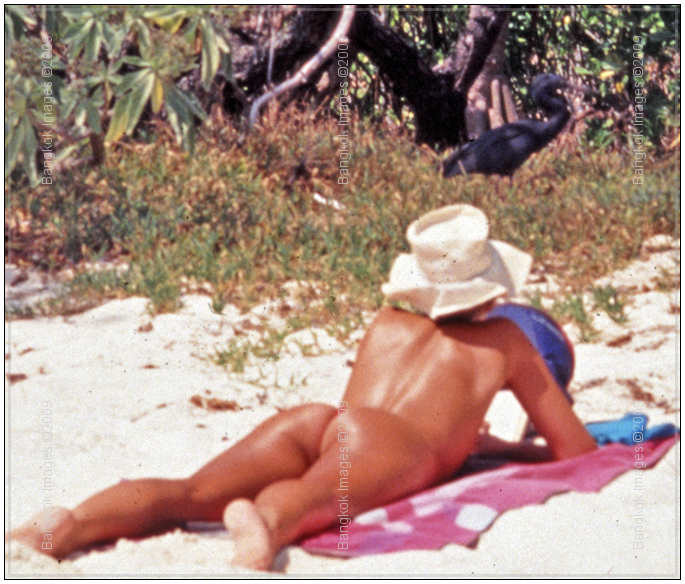The Traditional African Safari For Photographers Part 2

|
• Olhos d’Agua Hotel • Adriana Club Beach & Resort • Alfagar Apartments • Club Oceano Hotel Albufeira |
The Traditional African Safari for Photographers Part II
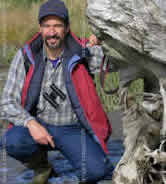
Dr. Palazzolo is a friend and a colleague and I’m delighted to introduce him to you once again in this column. His Antarctica special went over really well and many enjoyed it. Dr. Palazzolo
is an avid traveler, exotic animal veterinarian, and a wildlife conservationist. He teaches digital photography workshops on his exotic trips to Antarctica, Africa, South America and Alaska. Some time in the future I hope to include him in
one of our Thailand workshops so the participants will benefit from his knowledge and experience as well. This is the first of a two part comprehensive series on Africa which covers most every aspect of an African Photo Safari you could think
to ask. You can provide feedback to Dr. Palazzolohere, or visit his website.
(Please allow a few moments for this page to load)
My Guests Come Before My Photography (usually)
I usually take beginning and intermediate photographers, although professional photographers occasionally join me. Its not just about the photo for me as I try to show them the big picture in addition to shooting animals.
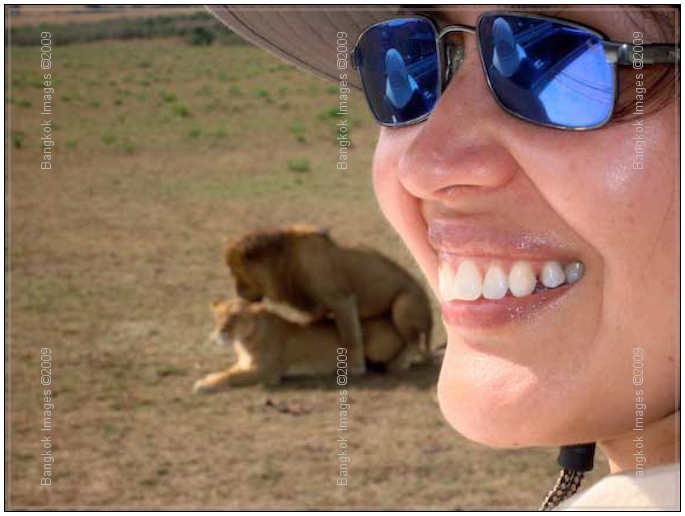
This is Norma on my second group in Kenya in 2007. She is on her honeymoon, so you know what is on her mind
A hallmark of my trips is the access all of my guests get to me and my professional equipment. Every game drive two of them come with me in my vehicle and commandeer my cameras and lenses. I adjust the settings for them and they are happy to practice
their focusing technique and pull the trigger. When they get one of those keepers to put on their wall they can tell their friends they took that photo and feel like they are good photographers. Everyone is happy and we have a great time.
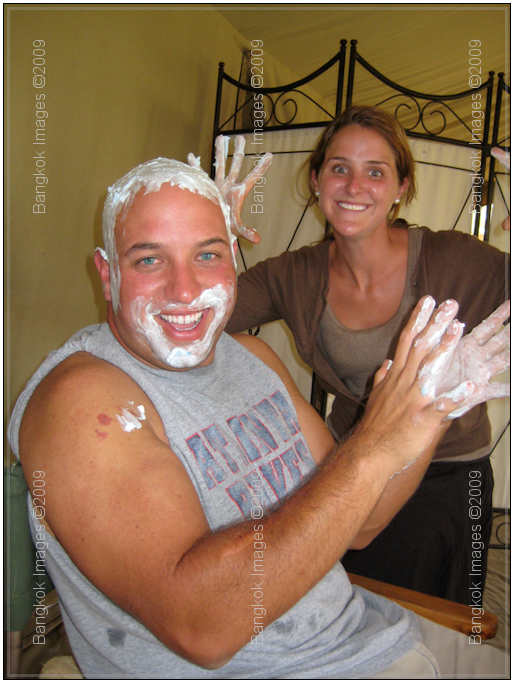
Some of my guests just know how to have fun

This is John, just a little hung over from playing Ibble Dibble the night before.
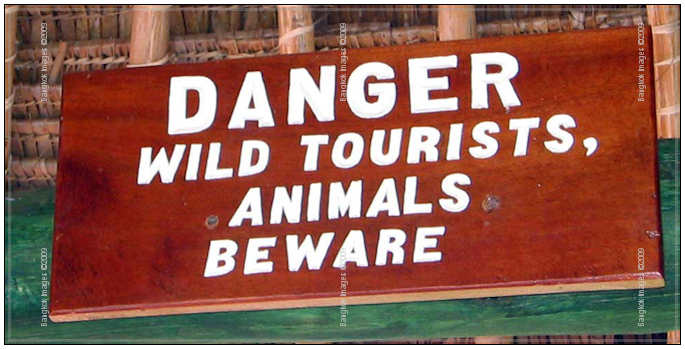
This sign applies to John while playing drinking games
The only time my guests don’t get to use my equipment is when something important is about to happen and I cannot risk them missing the action. This is why I put the word “usually” in
the heading to this section. This happened when I saw a lioness stalk and kill a wildebeest in Tanzania in July of this year.
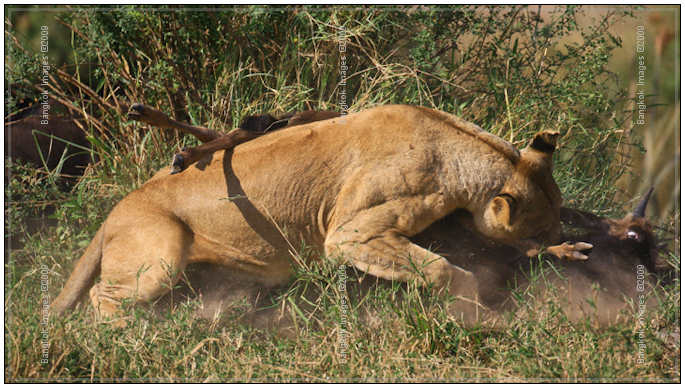
If you go to my photography link at the beginning or end of this page, and click on the Tanzania trip, you will get to see the whole sequence of shots along with an explanation.
Canon 1D Mark III, SS 1/4000th, Av, ISO 500, f/6.3, Canon 500 mm f/4 IS lens
I teach my guests the relationship between aperture-shutter speed-ISO for the constantly changing photographic environment on a safari. I probably go over this relationship several dozen times per guest, but still get the occasional “OK I get it, if I make the ISO higher the animal will appear larger, right?” Sometimes these trips take lots of patience on my part.
Most guests seem to do well shooting in aperture priority, so that is what I teach them when they are in the vehicle with me using my equipment. Since their shooting technique is still progressing I need to keep their shutter speeds up there. When they
are not with me and using their own equipment they can get confused, so I tell them to use the P mode. They believe me when I tell them the P stands for Professional. Everyone is happy, and they get betters photos than if they mess up the aperture,
so sometimes ignorance is bliss.
Speaking of messing up, its amazing how they can change camera settings without realizing it. Some guests are like inquisitive or destructive kids because they push every button they can.
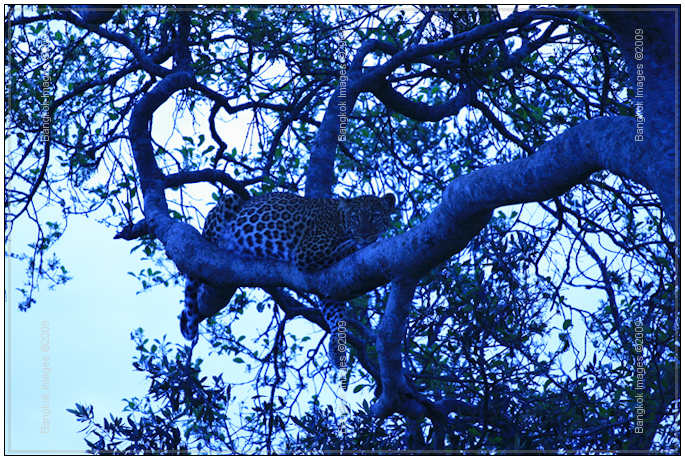
One lady asked me why all of her daytime leopard shots were blue. She had no idea how she set her white balance to tungsten.
Canon Rebel XTi, SS 1/80th, Av, ISO 800, f/4, Canon 70-200 mm f/4 lens
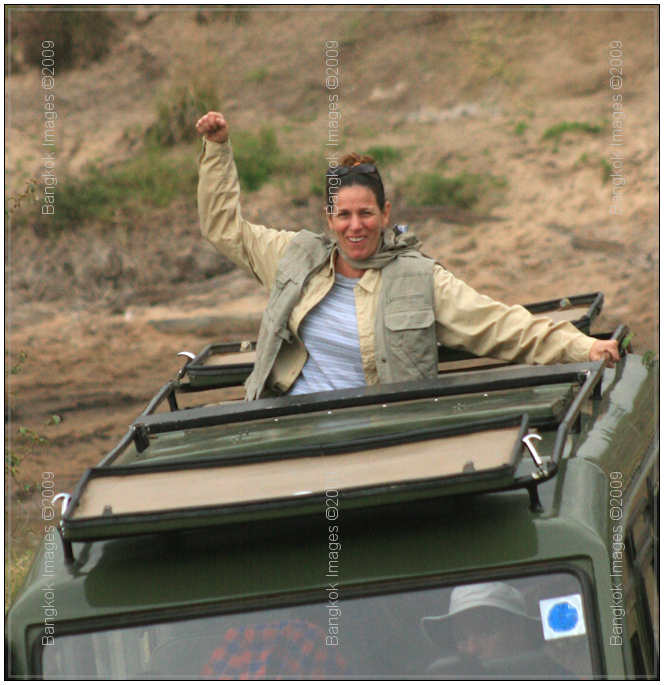 .
.
My main concern is they have fun, learn about photography for a few weeks until they forget what I taught them, and bring home a few keepers.
Canon 30D, SS 1/800th, Av, ISO 1000, f/5, Canon 70-200 mm f/4 IS lens @ 190 mm
I make a web page for them and even put on a post trip slide show so they can show off their trip to their friends. It’s a lot of work but I thoroughly enjoy it.
The holy grail of wildlife photography for me is catching the animals in action. Usually that means the predators interacting with the prey. These photos are hard to come by, and I have had been teased and disappointed many times when nothing happens.
I have two tales, out of my book of way too many, to share with you.
I was in the Masai Mara in 2005 with just one guest in a Range Rover watching some lionesses in the 10 AM sunshine. Even though lions are “supposed” to be night hunters, if opportunity presents
itself, or they are hungry, they hunt during the day. My guide stopped near them because he thought their behavior was peculiar. He said they were hungry and on the alert for prey, so he parked the vehicle in a spot he felt was advantageous.
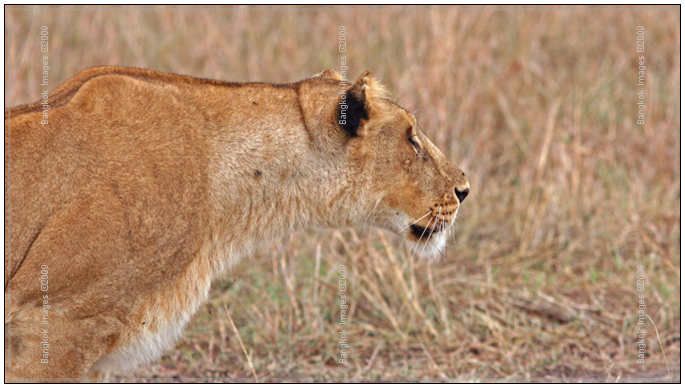
Within 30 minutes it becomes obvious that one of the females was looking at wildebeest in the distance, and slowly began her stalk
.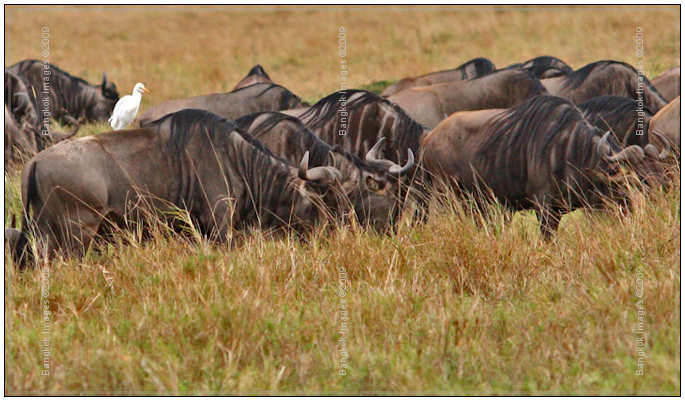
The wind was in her face and the wildebeest were oblivious to this lion’s presence 75 yards behind them
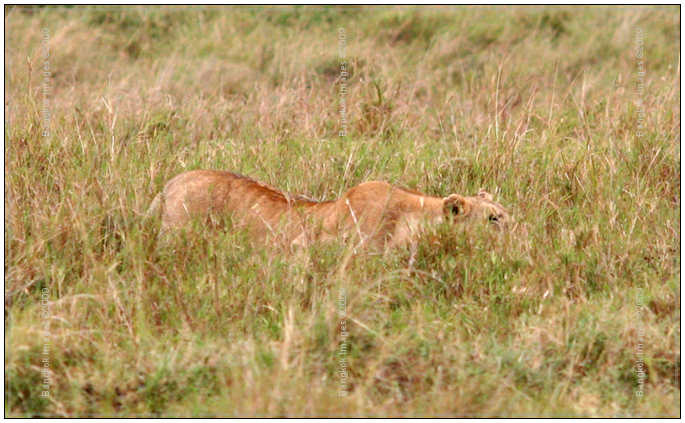
As the lead lioness continued her stalk the other two other lionesses stalked with her, staying 10 yards behind her at all times
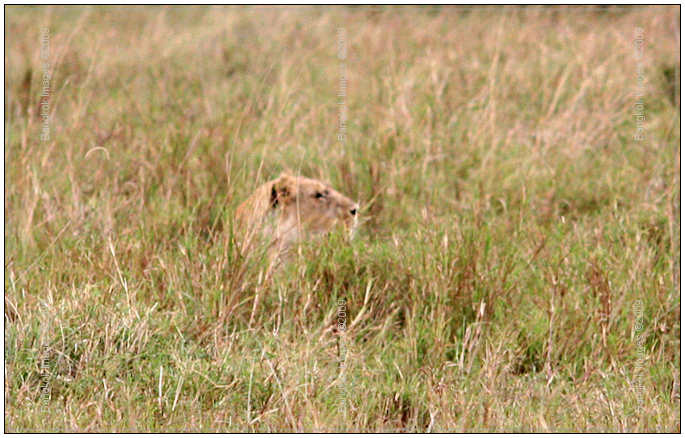
When the lead lioness got within 30 yards of the wildebeest she stopped and crouched down in the grass and just watched them. Finally we are going to see a hunt!
You can imagine our surprise when one lioness in the rear, well beyond any chance of capturing a wildebeest, jumped up and scared the grazing wildebeests away. When we asked our guide why she did that all he could do was shrug his shoulders.
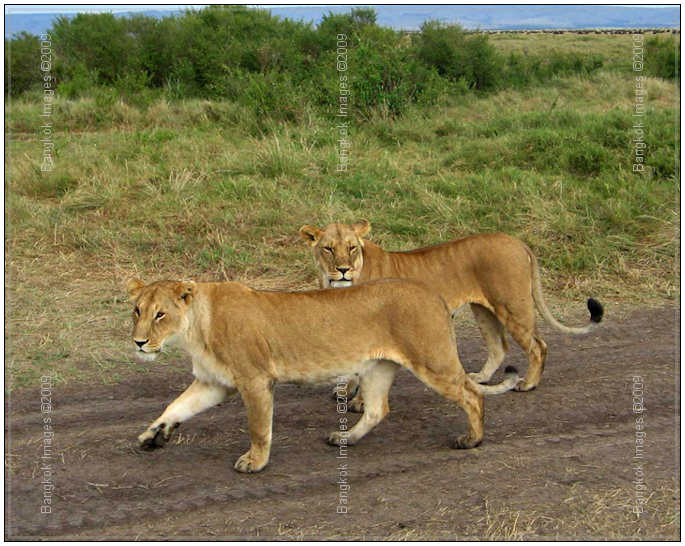
This is the lead lioness with the offending lioness walking right past us to the spot where they were originally resting. I could have strangled that stupid cat!
Even when the wildlife cooperate and actually act the way the books say they should, technically something seems to get in the way so often. Murphy must have been a photographer at some point in his life.
.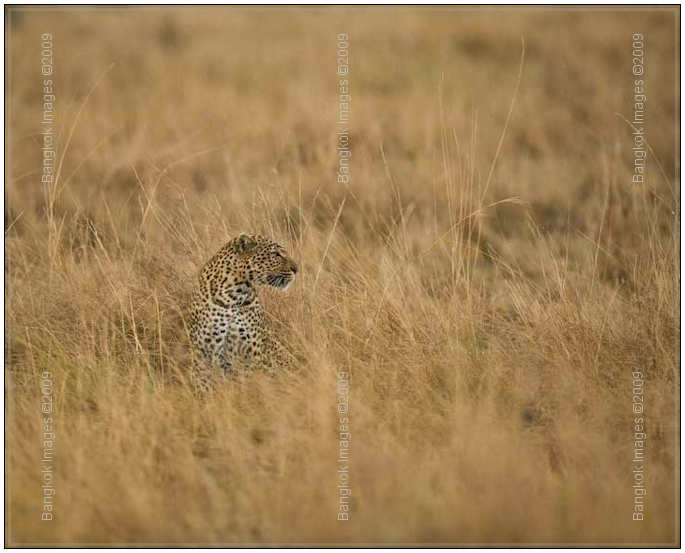
We had been watching this leopard in the Mara moving rapidly through the grass. She was in tall grass and the sun was cooperating, so I caught her just as she stopped and fixated on something in front of her
Canon 5D, SS 1/320th, Av, ISO 400, f/4.5, Canon 500 mm f/4 IS lens
.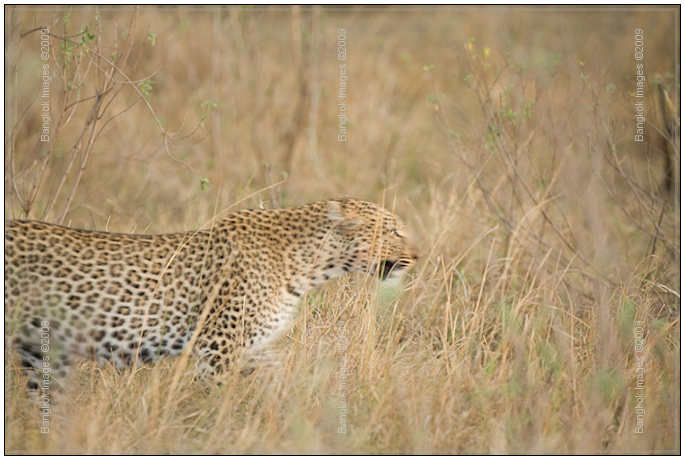
Our guide saw the warthog she was looking at so I had a one second heads up before he took off to follow her
Canon 5D, SS 1/60th, Av, ISO 800, f/5.6, Canon 500 mm f/4 IS lens
.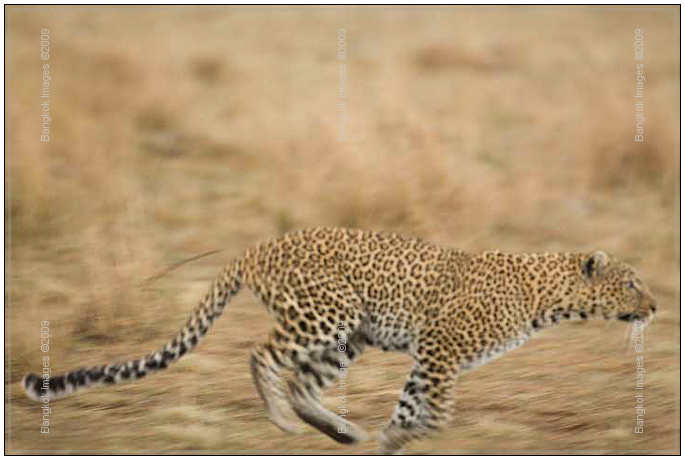
I got her initial charge as our guide was jockeying for position.
Canon 5D, SS 1/125th, Av, ISO 400, f/5.6, Canon 500 mm f/4 IS lens
.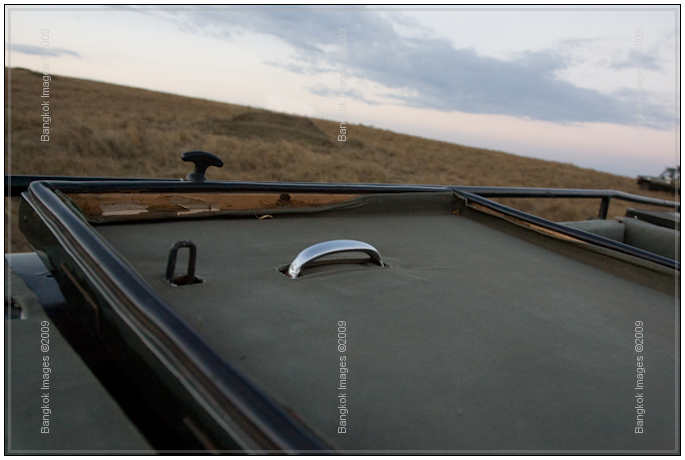
And my next shot was of a beautiful Toyota Landcruiser! It was one of several vehicles in our way and blocking any chance for a shot. By the time our guide maneuvered around them she was gone with a squealing pig in her mouth.
Where I am Coming From
Before I can give you any safari photography advice you need to know my bias, mindset, goals, and where I am coming from. Only then can you determine how this information relates to you. I will present my thoughts to you from a few different angles. I
have already mentioned some of them earlier.
Photography is highly subjective, and what works for you, or what looks good to you regarding exposure and composition, might be different to someone else.
Photography is quite personal, both in how you approach your shooting style and what you like to shoot. Find a method of obtaining the photo that works for you after trying numerous different methods and taking lots of photos. Once you determine your
style stick with it and perfect it so that on safari it becomes second nature.
I do not want to take dozens of photos of a scene, sequentially changing the f-stop or some other parameter, then spending hours in post-processing making it perfect, just to show off to my friends how good a photographer I am. People that do this have
photos that are extraordinary and catch my eye, yet taking them is not for me. I want unscripted and seat-of-the-pants pictures, even if not perfect, that recreate the beauty and emotion of the moment.
I like to take pictures of people, nature and wildlife in as natural of an environment as possible. Putting a cardboard background behind a hummingbird feeder surrounded by multiple flashes and cameras on remotes makes for awesome photo’s, again
it is not for me. I want to walk through a field and come across a hummer hovering over flowers and try to grab that shot before it flies away. I like the challenge of nature’s spontaneity with just a touch of photographic manipulation.
I don’t just post a bunch of my photos online just to show off pictures. I strive to take outstanding nature and wildlife photos that tell a story in a logical progression and to motivate those that might want to go on a trip, and share with others
that are unable to go on such a trip. I turn them into a story, and then share it with others when I print them out, put them in a slide show, or post them on my web site. Without this story its not quite the same to me as just looking at a bunch
of disparate photos. This is why I don’t just post my photos online by themselves very often.
Without the sharing part photography is just not as much fun. This is my version of photojournalism, and when accompanied by a good narrative those armchair travelers that cannot go on these trips are able to share the experience in a fun and informative
way.
My first goal is to capture some moment I think might make a good photo for my evolving story. This is so much easier said than done when you are on a safari. The biggest reason is probably because you have so much stimulation from what is going on around
you, in a relatively alien environment from what you are accustomed to, that it is hard to be instantaneously ready to get that important shot.
In other words, you are on vacation, acting care-free like you should, and not concentrating so much it becomes work. I see this all the time, and my guests sometimes get embarrassed because of the silly things they say and do. To me it just means they
are enjoying a well-deserved vacation and really enjoying themselves.
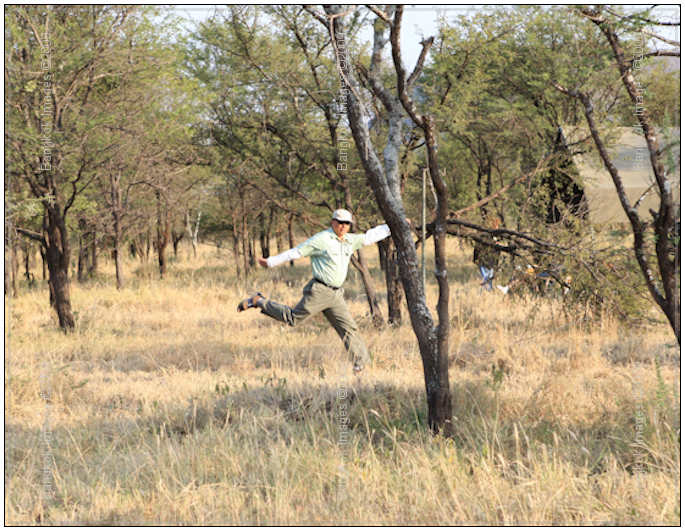
A relaxed (maybe inebriated?) guest transforms into a new sub-species of gazelle prancing through the camp
Another reason it is hard to capture that moment is the fact that events in nature evolve rapidly. Where there was nothing but still air and hot sun can suddenly become a dust cloud as a herd of Cape buffalo emerge from the bush and stampede past you.
For my ultimate purpose it is better to have an interesting photo that captures the feeling you want to share, and is not perfectly exposed, composed, or focused, than to miss the shot completely because you weren’t fast enough on the draw. This
happened in Zimbabwe in 1995.
After spending 2 weeks observing black rhino with the rangers in Hwange National Park in Zimbabwe I hired some local guides to take me around. They used to be big game hunters and now lead photo safaris. Their knowledge is impressive.
One of them named Andy took me out walking with him. Being a veterinarian paid off because he trusted me around animals. He said we could track lions as long as I followed his direction and never ran unless he said so. Of course I said yes and off we
went. He knew I was into photography and would try to oblige me.
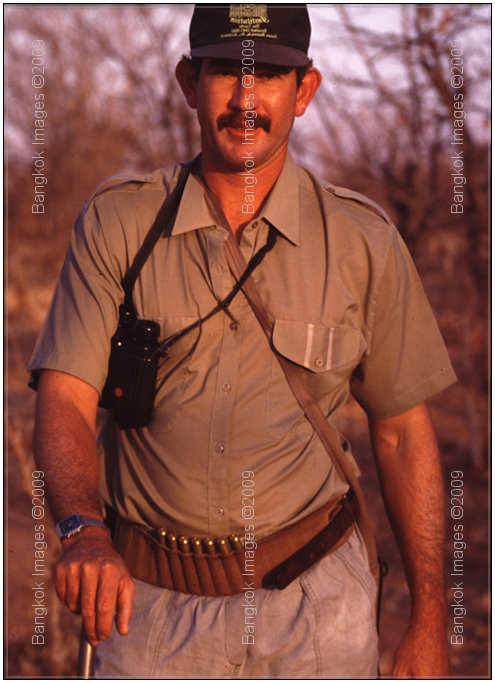
This is Andy, the ultimate bwana!
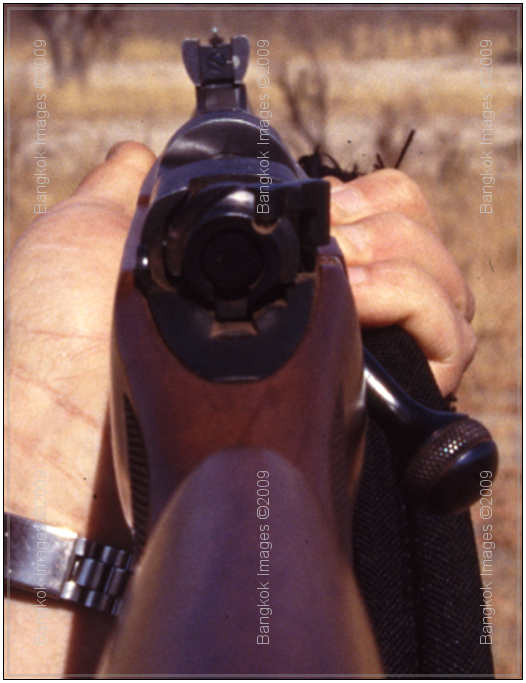
One of the few rifles these guides will use. It’s a Winchester Model 70 in 458 Winchester magnum caliber. The pre 1964 model has the bolt action prized by these guides. Those AK-47’s the park rangers use as an anti-poaching rifle are considered
pea shooters by these guides
We walked for a few hours until he found some lion tracks to follow. They eventually led to a cub that was sleeping with its mother. The cub heard us first and woke up. Immediately the lioness got up, growled, and started moving towards us. Andy raised
his rifle and literally pushed me backwards as he yelled “move back, move back” and flew backwards into me. I moved in unison with him and was prepared to keep on moving when he literally
grabbed my arm, threw me forward like a rag doll, and said “shoot the F’in photo”! I had a Canon EOS Elan film camera with a 100-300 zoom lens, and it was all I could do to point the
camera in the direction of the lioness and pull the trigger.
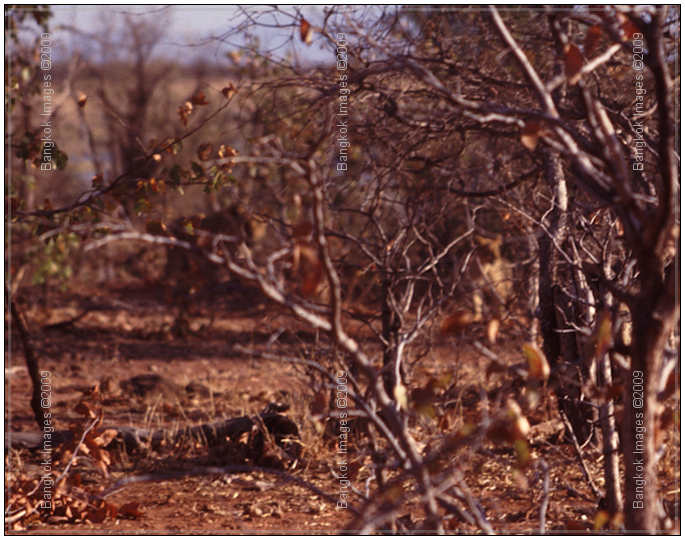
You can see the cub on the right and the lioness in the shadows on the left on the first of my rag doll technique shots
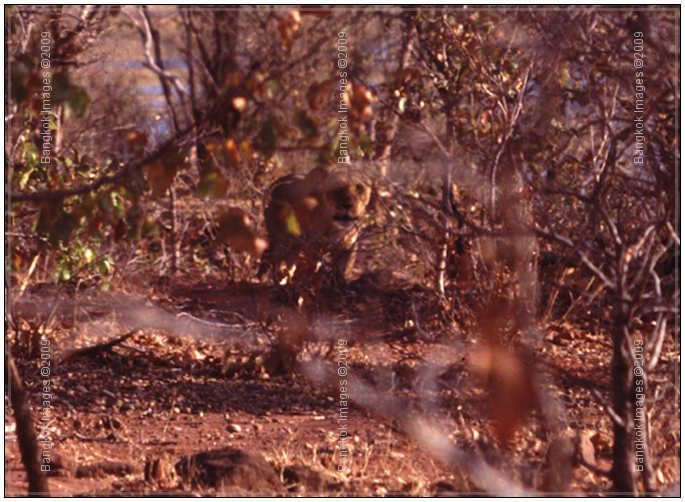
The cub is gone and the lioness is rapidly moving towards us
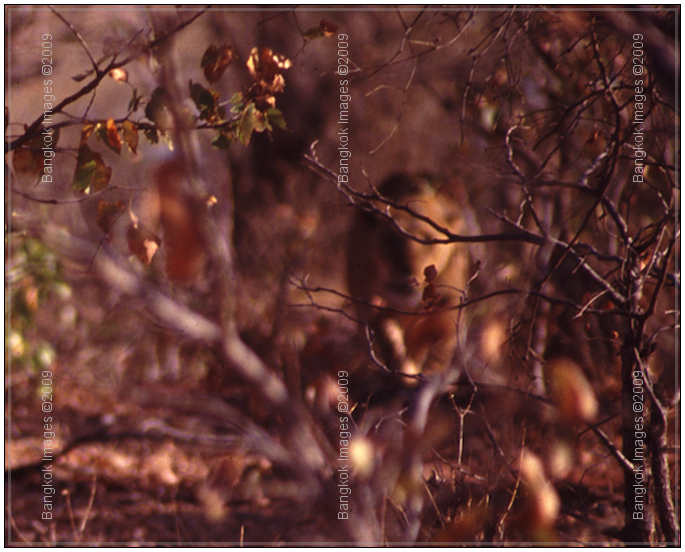
After a second he pulled me back behind him again, pushed us backwards several more rapid steps, and then threw me forward again to shoot more photos. She is still moving towards us at a good clip
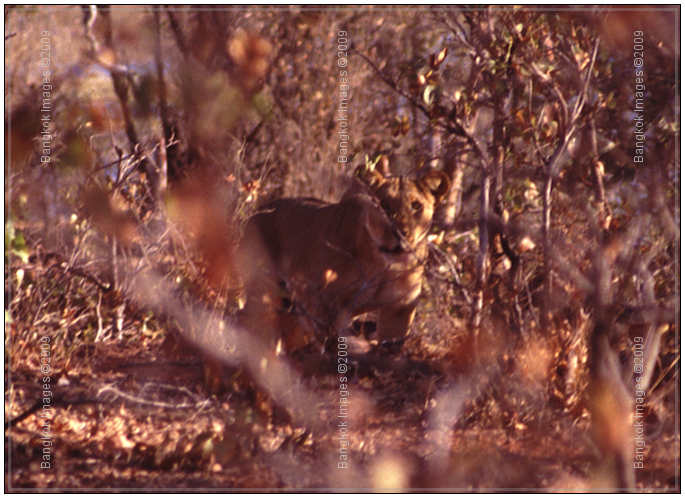
She stopped around 20 yards in front of us and drew the line. You can tell that because her ears are up. Of course at the time I had no idea what the heck her ears were doing. Only now when looking at the pictures and telling the story can I pretend like
I knew what was going on back then
At this point we high-tailed it out of there. With only 36 shots on a reel I ran out of film. During the whole process I was cool and calm, but when we got to a safe place and I changed film my hands were shaking like a leaf. Andy told me should could
have covered that 30 yard distance between us in 3 seconds had it been a serious charge. He took a big risk because we could have been injured or killed. He could have injured or killed the lioness, thus dooming the cub. He would have lost his
guiding license either way. Yea Andy!
My point is these poor images can tell a story, and that is just as important to me sometimes as getting that perfect photo.
After I have recognized an important scene and capture it my next goal is to get it in sharp focus. Out of focus shots are the bane of many safari photographers. The remedy is practicing with your camera prior to the trip, knowing your lenses and their
optimum apertures, keeping those shutter speeds fast, and knowing how to use the beanbag to stop camera movement.
Now that I have the shot I want and have it in focus I next worry about exposure. I shoot RAW almost always and do not worry so much about exposure when the action is on because of the ability to correct exposure in post processing. Use whatever camera
mode makes sense to you, check the histogram as needed, shoot to the right if that works for you, but make sure you get that shot and get it in focus first.
Studying your histogram after you shoot is a great idea to adjust exposure. But not if you miss that leopard jumping out of the underbrush at a bushbuck because your eyes are on your camera’s screen and you got so caught up in looking at your photo
that you forgot what I have been trying to beat into your head during the trip- wildlife appear when least expected.
.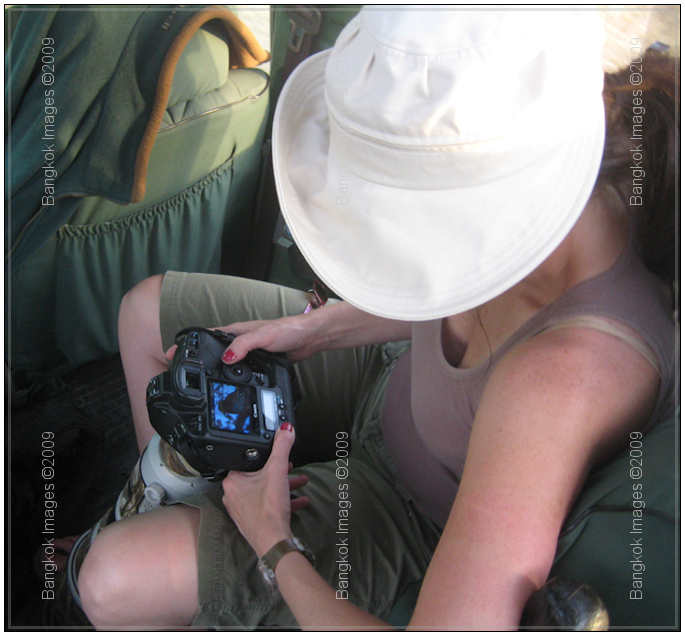
This is a good time to delete those lousy photos that for some reason are not in focus- go figure!
This leads to what I call some of my “axioms of photography.” They are big picture items to keep in mind before you delve into the details of that photo on safari.
Axiom #1
The first axiom is “the best photo in the world is not on the cover of some fancy schmancy magazine like National Geographic.” It is the photo that you take, you like, and has meaning to you.
Its your trip, so take the photos you want. When you go on a trip with me my role is to help you get photos that are important to you, not me, although I will give you feedback on when it might be a good time to take, or not take, that photo.
Axiom #2
The next axiom involves “recognizing a good photographic opportunity when it is staring you in the face.” This might be good composition, good lighting, or animal behavior that is truly unique.
You have to think like a photographer and visualize what might look great later on a computer screen, hanging on your wall, or will tell a compelling story. You need to stay proactive and anticipate. And you need to tell the driver “stop” (say “simamma” in Swahili) when something potentially photogenic captures your eye. If you are with my group your guide will always stop whenever you want, unless it is dangerous or we need to be some other place pronto.
Axiom #3
My last African safari axiom, and maybe most important is “get the photo.” I brought this up earlier because it is of critical importance. Of course this makes sense, but is much harder to
put into practice than seems at first glance.
Why is this harder than it seems?
I already mentioned a few mindset obstacles regarding people enjoying their vacation. Here are some other reasons my guests have problems here. This list is by no means comprehensive:
You try to take a photo of a situation that is so fleeting that there is no time to focus, yet you try to focus. In that millisecond or two you were delayed you missed the moment. Sometimes you have to point the camera and pull the trigger and keep your
fingers crossed, all in the span of about a half a second.
In 1991 I was in Borneo, using my Minolta XG-M semiautomatic film camera with my 24-105 zoom lens loaded with 400 speed film. In that era this was considered high speed film. At 4 PM every day the semi-wild female orangutans were fed a mixture of milk
and rice to help them as they were adapting from years of captivity to being on their own in the jungle. The photographic opportunities at this time were awesome because they congregated around the feeding area early in anticipation of the food
to come.
.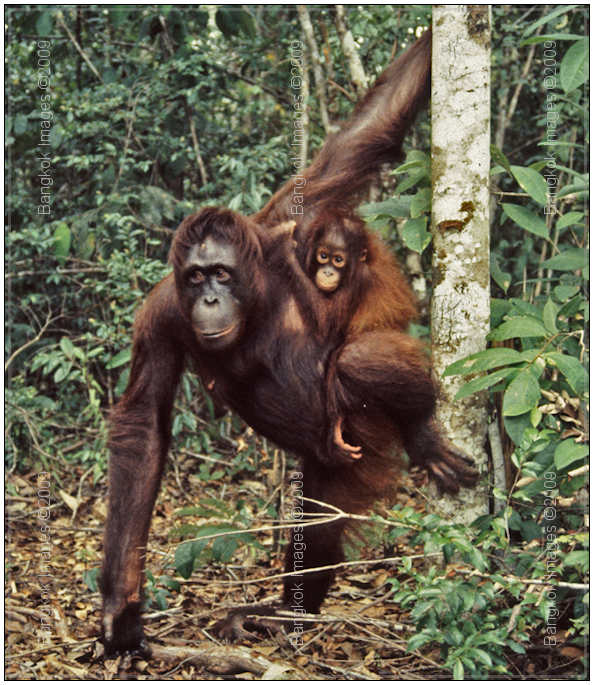
Her name is Uni and this is as close as she will let you approach, which is about 15 feet away
As I was snapping away I noticed something out of my left eye (you do keep both eyes open when you shoot don’t you?). It caught me by surprise and I knew it might not last long, so I spun and just
pushed the shutter without even focusing (it was manual focus only). I got lucky, although I had to wait for several weeks until I returned to the U.S. to get my film developed. I did a lot of praying during
those two weeks.
.
.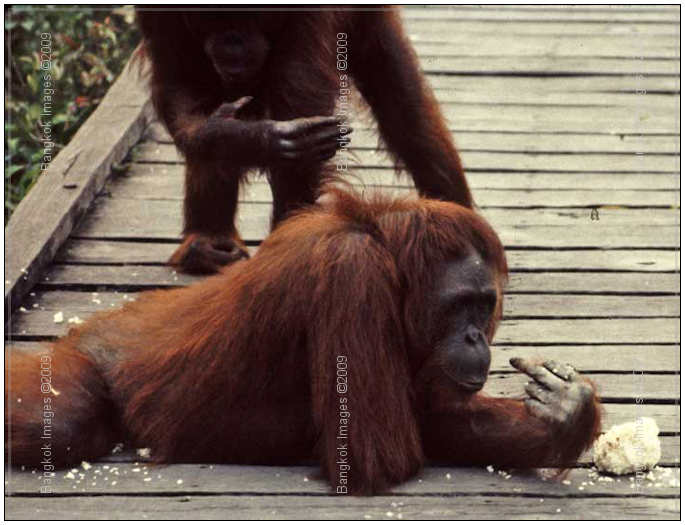
Here is our lovely female orangutan giving us the universal gesture of love
.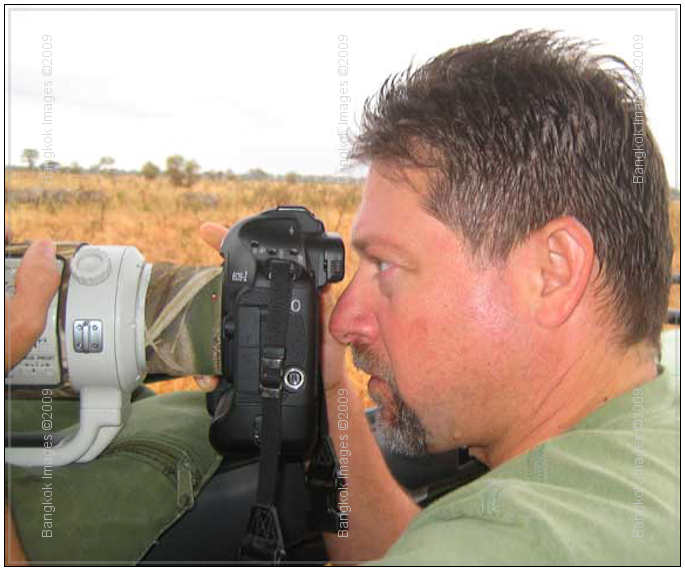
It takes some practice to shoot with both eyes open. Sometimes the payoff is worth it. Dominic is showing good technique with the 500 mm. Both eyes are open, his left hand is stabilizing the lens to minimize vibration, and he is solid on the beanbag
Another common impediment to getting a good photo is having the incorrect lens and there is no time to change lenses. This is where zoom lenses can be helpful, but not always. If you have the money and don’t care about the weight, that extra camera body and lens is the way to go
.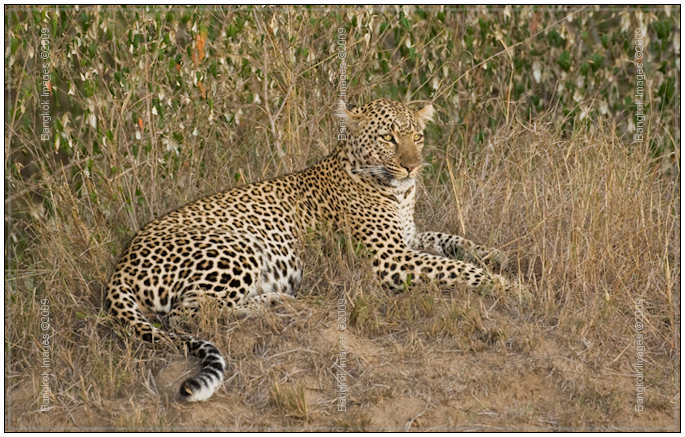
It was getting dark and this female leopard was calling her young hidden in the grass
Canon 5D, SS 1/80th, Av, ISO 800, f/5.6, Canon 500 mm f/4 IS lens, flash on
.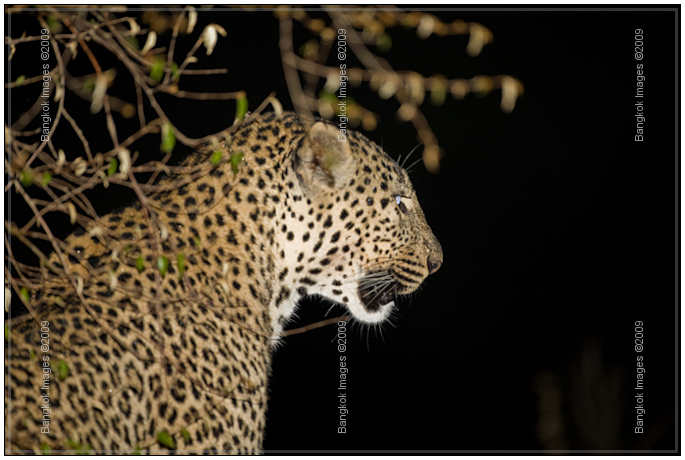
All of a sudden she got up and started to move rapidly to her right
Canon 5D, SS 1/60th, Av, ISO 800, f/5.6, Canon 500 mm f/4 IS lens, flash on
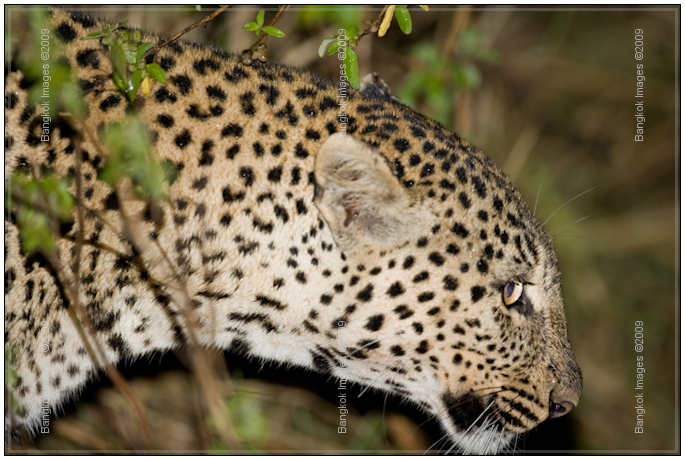
We were way to close for this lens but there was no time to change and I did not have an extra body with a wider angle lens
Canon 5D, SS 1/60th, Av, ISO 800, f/5.6, Canon 500 mm f/4 IS lens, flash on
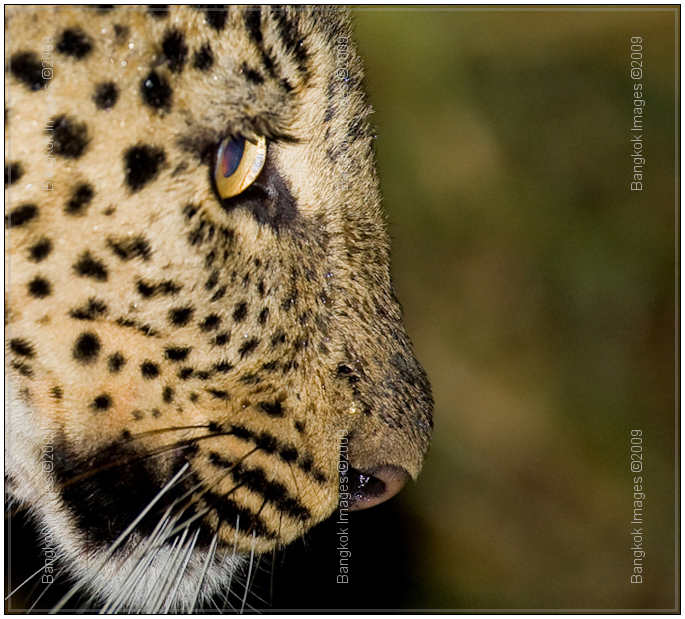
I pulled back as far as I could so I could keep her in the minimum focusing distance of the 500 mm as she disappeared into the bush. I got lucky on this one. Animals this close are usually out of focus when using a 10X lens like the 500 mm
Canon 5D, SS 1/60th, Av, ISO 800, f/5.6, Canon 500 mm f/4 IS lens, flash on
Oftentimes your camera does not have the correct settings regarding shutter speed and aperture, or as a corollary, your shutter speed is too slow. You need to constantly do test shots to assess that shutter speed and decide on your background blur
(bokeh).
You don’t prefocus in order to catch some future action that will transpire so rapidly that autofocus might not be fast enough. You saw this technique earlier with the Martial eagle.
You do not have enough batteries for your flash. Flash is important in daytime and evening photography. Bring more batteries (depending on the weight of your bags) than you need and leave the extras as a
present.
Your camera is inaccessible at the moment you need it. Even though I advocate putting the camera away and enjoying the scenery at times, your camera should be instantly accessible.
The last one is a biggie. You are not familiar enough with your camera and lens to instantly point, focus, shoot, review, and then make a settings change to get a better focus, composition, or exposure. Its all instantaneous and needs to become second
nature if you want to be successful.
It is better to have mediocre equipment you know well than to chase the latest and greatest camera technology, and then reading the manual on your airplane flight on the way to your safari to get familiar with it. Yes, the long anticipated Canon Mark
IV and Nikon DS3 have been announced, but before you place your order see how good you can be with your current equipment.
Understanding and Finding Wildlife
Before you can take any wildlife photos you need to find the wildlife. This means you need the safari guides to drive you where they are, spot them when they are hidden, and get you as close as possible without the animals fleeing or endangering the occupants
in the vehicle. I can sum it up pretty easily- no guides means minimal wildlife found. If you are interested in coming back with the photos of animals that interest you, and if you want your photos to impress, put your money on a group of excellent
guides before you upgrade to that new camera or lens you are eyeing.
When the vehicle is on a game drive down a road I assign everyone a direction to look in. All too often occupants are looking in the same direction and minimizing their chances of seeing wildlife. The guide who is driving tends to look forward, although
they have eyes in the backs of their heads and don’t miss much. Besides me I usually take 2 other guests maximum per vehicle. One of my guests looks on the right side and towards the front, my other guest looks on the left side and toward
the front. I scan everywhere. Don’t forget to look directly behind because as the vehicle goes by it is not uncommon for an animal to scamper across the road. Everyone seems to forget that point.
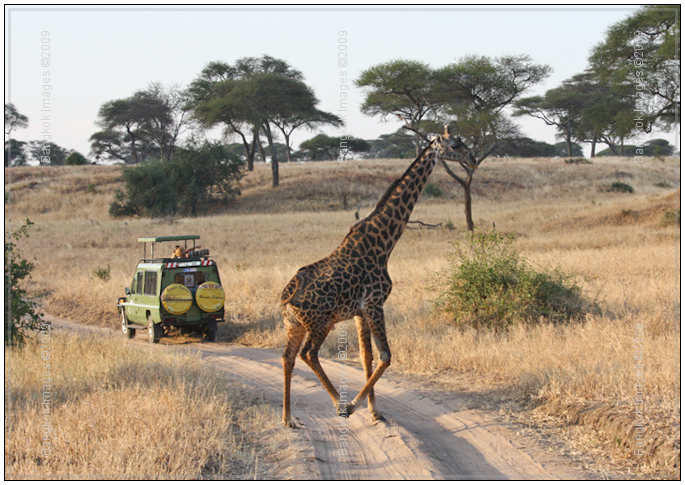
Giraffe walking behind us in the Serengeti. Do you know what kind of giraffe this is?
Canon Rebel XSi, SS 1/200th, Av, ISO 400, f/6.3, Canon 70-200 f/4 mm lens @ 70 mm
Many dedicated and intelligent people have observed wildlife and shared this information with us in books. They are a superb source of information and you should purchase and memorize every field guide for East Africa. The guides will have some of them
in the vehicles for you use.
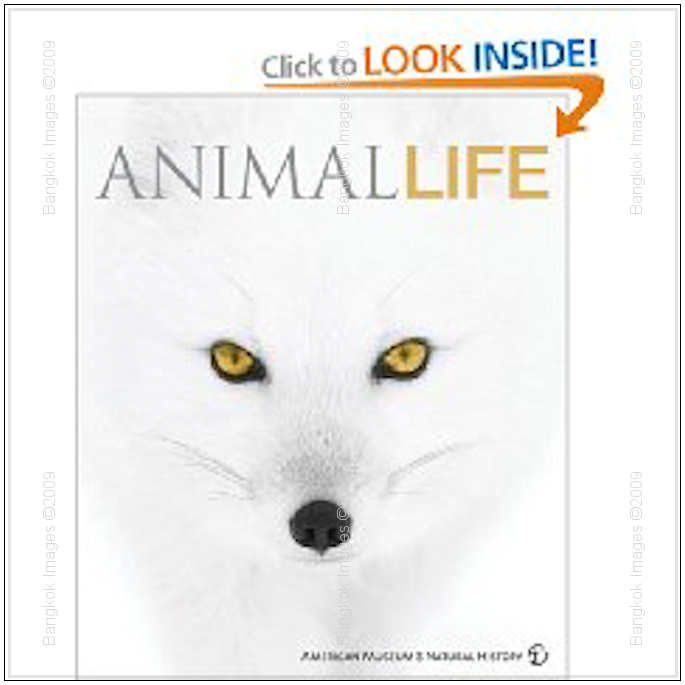
One of my favorite animal books in general is called “Animal Life” by the American Museum of Natural History.
I read it often because there are so many good pictures and explanations that I cannot keep it all in my head. It’s a tome so you won’t be bringing it on the trip. It would make a good present for someone planning a safari because it comprehensively
goes over the big picture of many different animal species and how they interact. This will prime you for the complex ecosystem encountered on your safari.
An interesting conversation occurred on my Tanzania 2009 trip with the head guide before the trip started. He mentioned the animal behaviors we have learned over the years from TV documentaries are not always correct based on their experience. He wanted
me to tell my 19 guests to be open minded and listen to the guides because they are experts on the local wildlife.
Animals are unique just like us, and they don’t always read the books we read on how they are supposed to act. This variability makes it interesting, and makes for good photography, when you observe a behavior that just does not happen according
to the experts who write about them.
An example of this occurred on the Tanzania trip while watching a leopard. In the “Animal Life” book, on page 235 it states “However, although they are good climbers, leopards cannot descend from tree branches head first, so they have to scramble down backwards, turning to jump as they reach the ground."
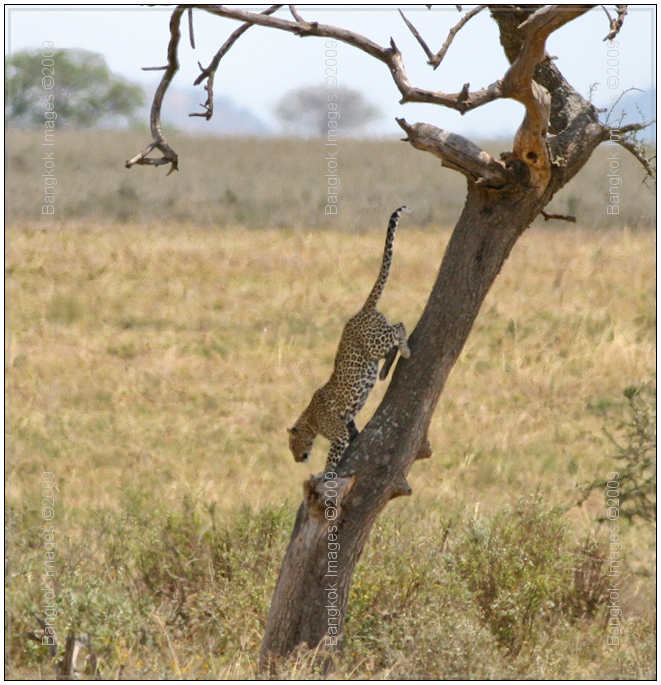
From my best recollection this leopard came down head first almost the whole way down
Canon 20D, SS 1/1600th, Av, ISO 400, f/5.6, 400 mm f/5.6 lens
Don’t forget to use all of your senses and not just your eyesight. In Borneo the young Dayak guides listen for orangutans before they look into the dense tree canopy. Once they hear them they move closer and start scanning for them.
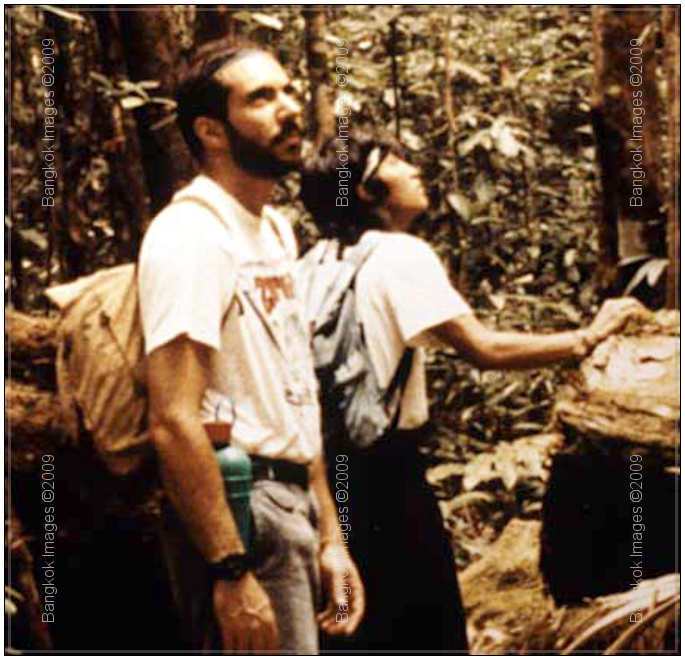
If you plan on finding orang’s in Borneo be prepared to get a stiff neck
A common mistake made by my guests is pointing out a lion or hyena in the distance (and sometimes fading light) that turns out to be a rock or log. Don’t be afraid to yell out “lion” when it is actually a warthog because every once in a while (I should say every once in a great while) you will be correct. You don’t want to miss a predator ready to pounce, but you also do not want
to make a fool out of yourself and think a rock or log is a predator. When in doubt ask and if you have good guides they will stop any time you ask (remember “simamma”). They usually know instantly
what you are looking at. Occasionally they will pull out their binoculars to confirm.
Lets test your ability to find hidden wildlife. Please understand that I am taking a 3 dimensional scene and portraying it in 2 dimensions for you to view on your computer screen. This might make it difficult for your brain and eyes to process this information.
But then again, you are getting a picture that actually contains wildlife, and has been cropped to the section that has the wildlife. When you are on safari and having to scan 360 degrees without knowing if any wildlife are present you still have
a challenge processing all of that information. So I guess it all evens out. Here we go- good luck!
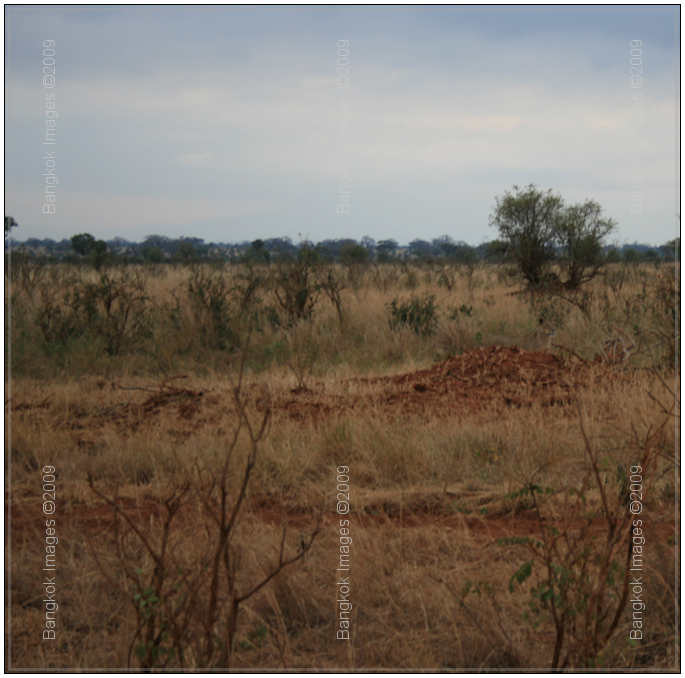
I will make the first one easy
Canon Rebel XSi, SS 1/200th, Av, ISO 400, f/6.3, Canon 70-200 mm f/4 lens @ 200 mm
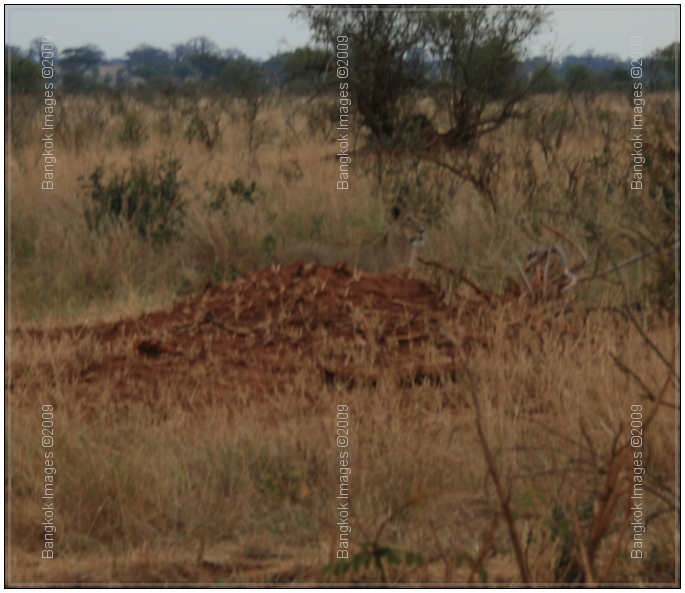
It’s a lioness partially hidden behind the dirt mound on the right
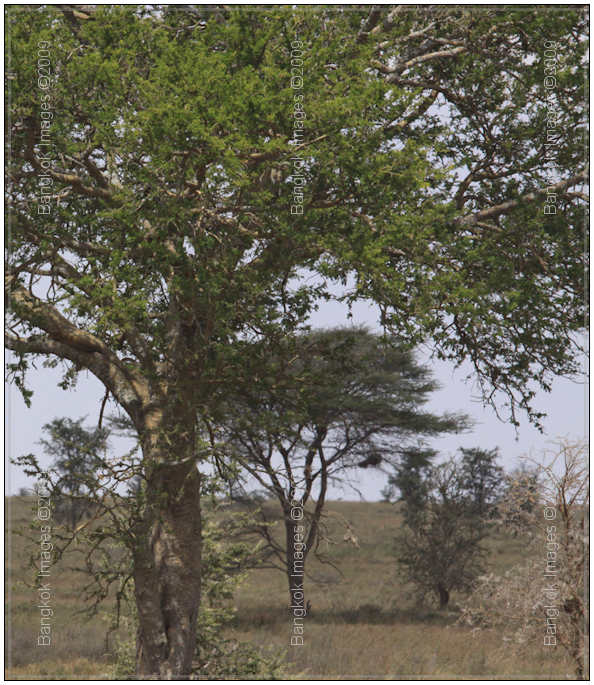
This next one is just a touch more difficult
Canon 50D, SS 1/2000th, Av, ISO 400, f/6.3, Canon 70-200 mm f/4 lens @ 200 mm
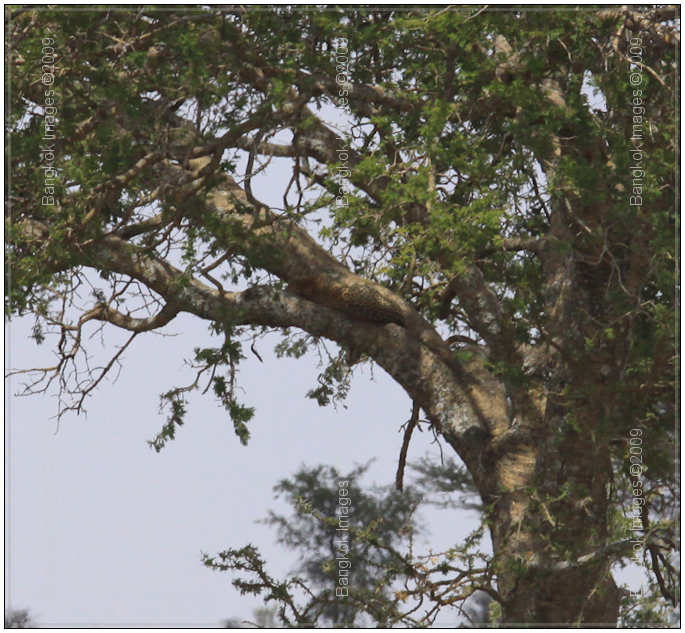
It’s a leopard with its back towards us laying in the horizontal tree branch to the left
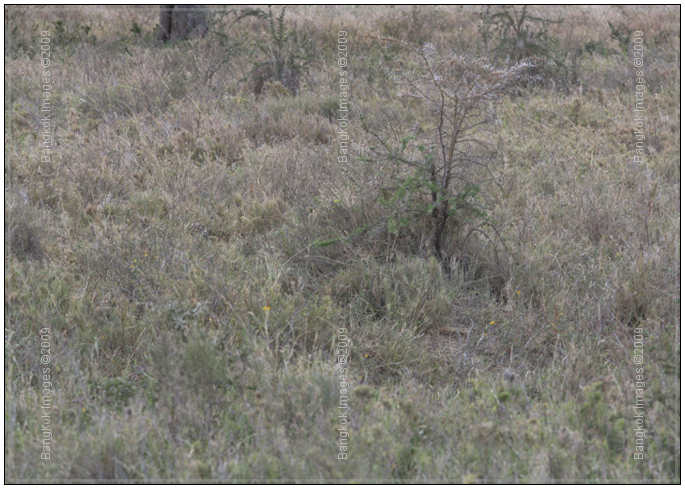
This last one’s a toughie
Canon 50D, SS 1/2000th, Av, ISO 800, f/4, Canon 70-200 mm f/4 lens @ 200 mm
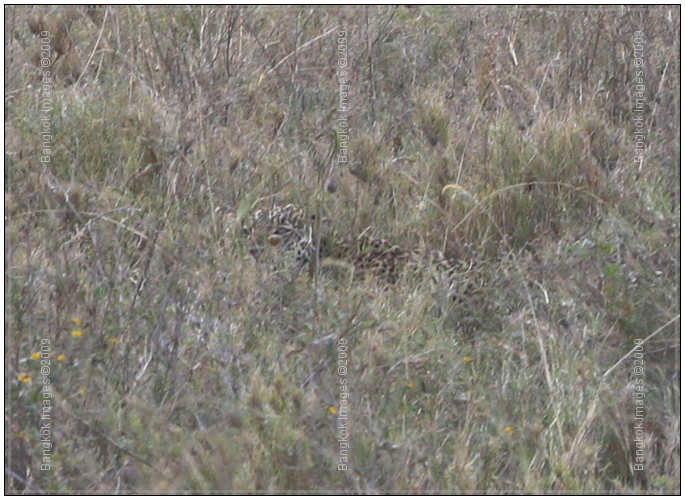
It’s a leopard hidden in the grass at around the 9 o’clock position. If you can’t see it back at the original scroll down past this close up where I marked it with an arrow
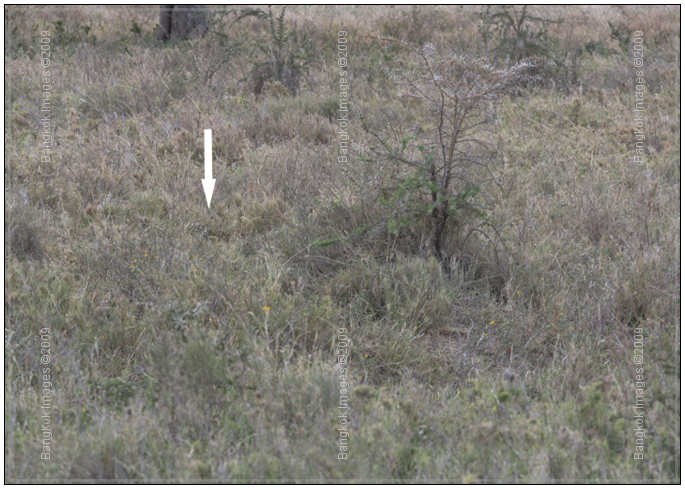
The arrow is pointing to the back of its head
Before we finish this wildlife section lets talk about bugs and snakes. The most common pre-trip questions regarding wildlife are how many bugs will there be and what about snakes. It seems our society is filled with people paranoid about both of these.
Some people will not go to Africa because of bugs.
Forget about the bugs, they aren’t worth mentioning because you will be at a relatively high altitude on safari in East Africa. There will be bugs and some mosquitoes, but I have encountered far more bugs and mosquitoes in 5 minutes during a Michigan
summer than I have during a ten day safari.
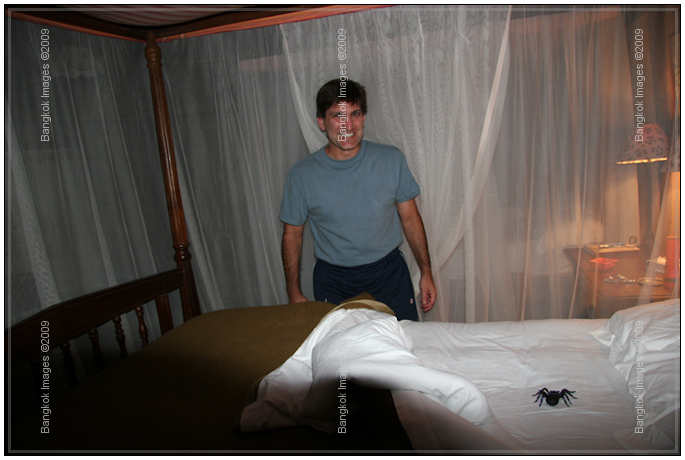
Just in case you do not come across any spiders make sure you bring a fake one to scare somebody
Canon 20D, SS 1/60th, Av, ISO 400, f/4, Canon 17-40 mm f/4 lens @ 17 mm
What about snakes? I have seen 3 of them in all my safaris, and that was only on the last two of the five I have been on. They were all spotted by the guides and we would not have seen them on our own.
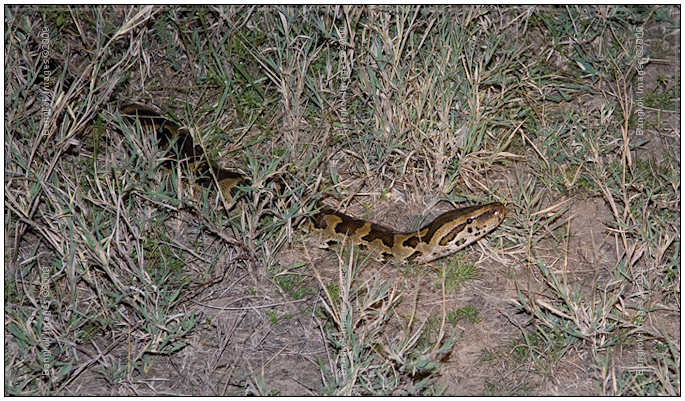
The first one was a rock python in Kenya. We were in our vehicle in the early evening and going down a road looking for lions. The guides spotted it off road 30 yard away and we drove over and took some photos. It didn’t seem to notice us and just
slithered on it way
Canon 5D, SS 1/60th, Av, ISO 400, f/4, Canon 24-105 mm f/4 IS lens, flash on
On this same trip two days later we were driving down a road and all of a sudden the driver hit the brakes so hard we had to hang on. A black mamba was crossing the road and rapidly moving to the other side.
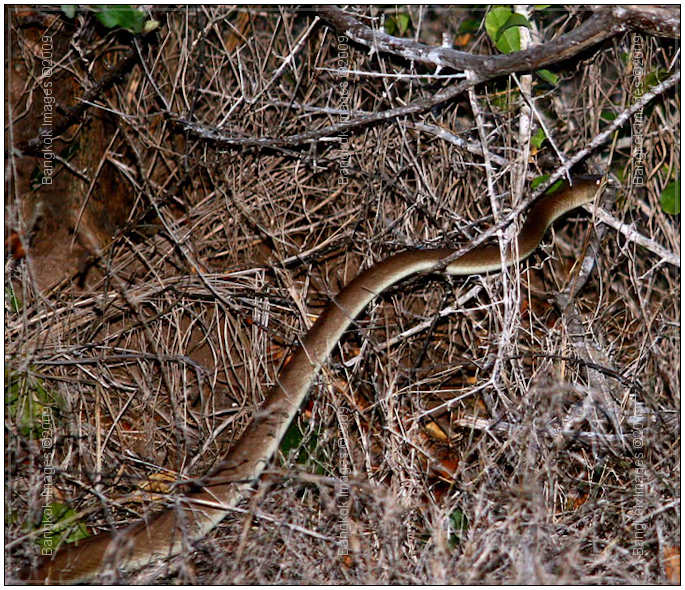
I got what photo I could before it sped into the underbrush. Its called a black mamba (as opposed to the green mamba), because the inside of its mouth is black.
I must admit that snake freaked everyone out, and even the guides were animated as they recounted the experience in Swahili. That mamba was large, moved quite fast, and moved in a very aggressive way with the front 1/3 of its body off the ground and head
scanning in all directions. Even though I am an exotic animal veterinarian and work on snakes frequently one mamba on safari is plenty.
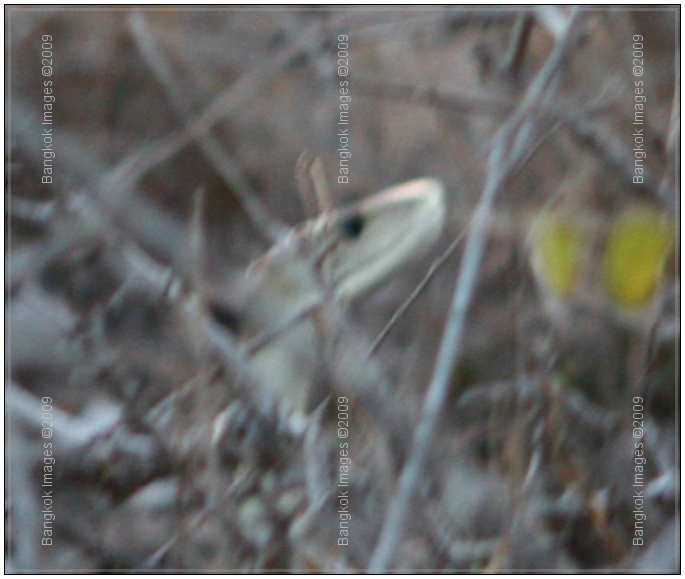
This is the best I could do under the conditions of a rolling vehicle, fading light, and my hands shaking from both fear and excitement as it turned and gave us a stare before it finally disappeared
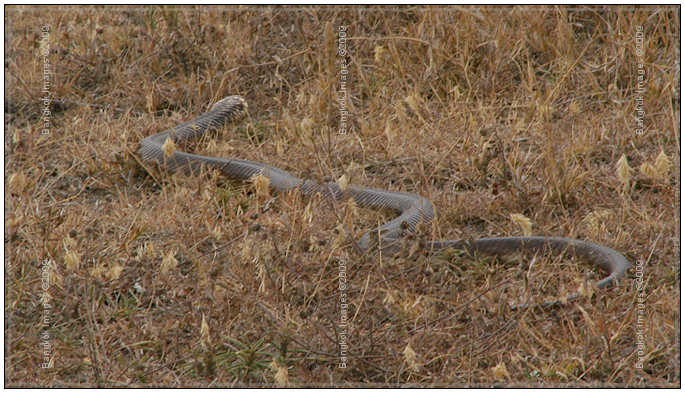
The last snake was an Egyptian cobra taken by one of my guests in the Ngorongoro crater. Again, the guide saw it first and by the time I got there it was slithering away through the grass
Camera Equipment
Now that you have budgeted your money where you should, which is on a good safari company, learned all about the wildlife and the ecosystem you will be in, understand you are going to get bored to tears while you are oh so patient, and have practiced
and practiced, lets talk about camera equipment.
Everybody has strong opinions here and I can easily start World War III giving advice. You have to try different things and see what makes sense to your style of photography and budget (and don’t forget weight).
I will put in my two cents along with the feedback from the guests I take. Since I know Canon cameras best it will be a “Canon centric’ point of view that you might need to adapt to your equipment.
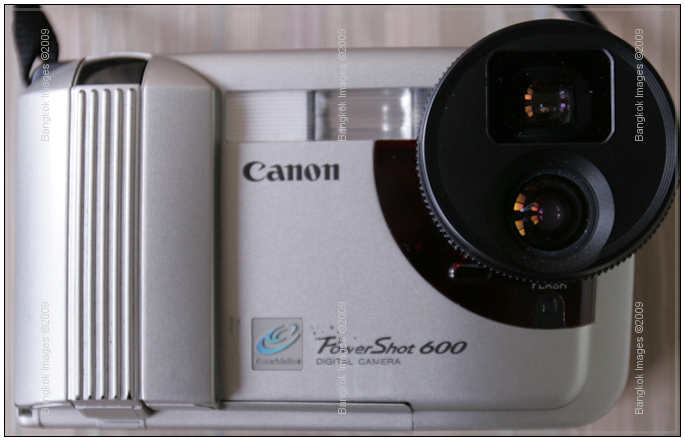
I have owned almost every Canon digital camera since the first Powershot came out in 1996. It cost me over $1,000 and had a whopping .5 effective megapixels. It had a docking station because there was no flash memory and I used Photoshop 3 on my Mac SE/30
to edit.
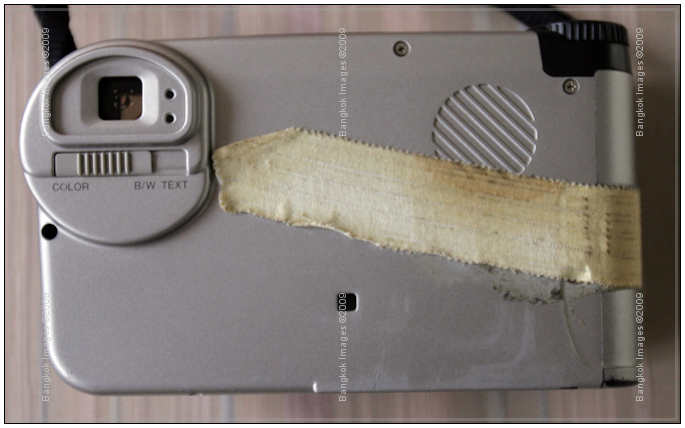
I used it so much, and dropped it so many times I had to tape the back. The battery died and I could not find a replacement so I reluctantly put it to rest after a few years.
People sometimes ask me whether I recommend Nikon or Canon. To me its like Mac or Windows; use what your are familiar with or what seems natural to you. They both take great photos, although Canon seems to have a wider variety of lenses.
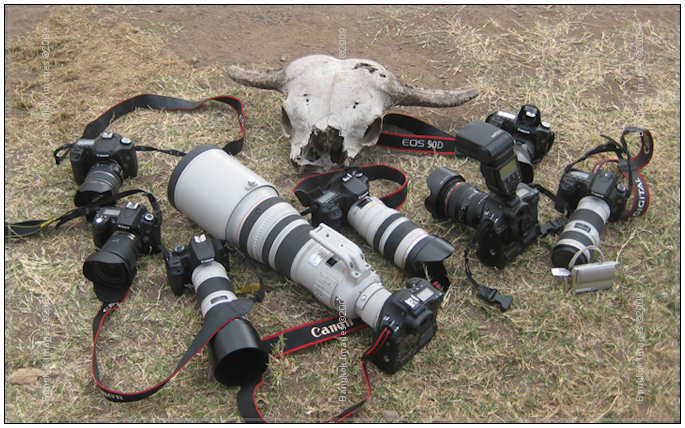
This is a picture of some of the equipment my guests brought (mine is not included) on the Tanzania 2009 trip. There is only one Nikon. This is an advantage to the Canon shooters because if a lens breaks (which did happen as I mentioned earlier), or you
just want to share a different lens, it is readily available from other Canon shooters. Our lone Nikon shooter would have been out of luck if his equipment malfunctioned
This is what I took on my recent Tanzania trip. I consider this traveling light. Normally I would not bring the 400 mm, it was an extra lens for my guests.
Canon 1 D Mark III and 1 Ds Mark III
Canon 24-105 mm lens
Canon 400 mm f/5.6 lens
Canon 500 mm f/4 IS lens
Canon 1.4X TC
Canon 580 EX flash
I use Canon Mark III’s for all my safari photography. I like their robust nature, the weatherproofing and the long battery life, and have not had the infamous autofocus problem.
I tend to use the 1Ds for the more static photos and the 1D for the action sequences. If I were limited to one body I would bring the 1D and not the 1Ds. For my style of photography I prefer the higher frame rate over the extra megapixels. This differentiation
is starting to become moot with the announcement of the Mark IV.
Many of my guests borrow or rent camera bodies for their trips. They have been quite happy, and I highly recommend this if you don’t already own a camera. At the least it gives you a chance to check the camera out for future purchase. This also
gives you the opportunity to bring a pro body if your only need for a camera is your safari.
I have used a wide variety of lenses on these 23 years of wildlife trips. I don’t make my decisions and recommendations based on specifications. I will only comment on Canon L series lenses that I have actually used and not just read about.
Part of the problem on deciding what to bring is the wide variety of overlapping lenses that Canon makes. Even though this can make your decision more confusing it does give you options that might better suit your budget and photographic needs.
When Peter Read Miller went on my Masai Mara trip he brought a ton of Canon equipment, including prototypes he is field testing for them. This has given me a unique opportunity to test a wide variety of lenses in the field. Next time I hope he brings
his 800 mm (as long as I do not have to trudge it through the airports).
Much is written about wildlife photography taking place early and late, when light is low and you need a bigger aperture. There is no doubt to the validity of this statement, so if you want to purchase those heavy, large, and expensive f/2.8 telephoto
lenses like the 400 mm f/2.8 and the 300 mm f/2.8 I highly encourage you. They are the finest optics Canon makes. And you will think about them every time you heft them.
Looking back at many of my wildlife photos though I see they were taken when there was plenty of sun, and in spite of what might be called “harsh shadows”, I got the photo I wanted. So those
much lighter and less expensive f/4 versions of these lenses can work great also.
So now I take mostly f/4 lenses. I put the 24-105 mm IS on my 1Ds and my 500 mm f/4 IS on my 1D. I like to travel light and usually take only these lenses on my safaris. With the ever increasing ISO’s of the new cameras and the new generation of
Image Stabilized lenses I am liking the size and weight of the f/4’s over the f/2.8’s more and more. Do your own comparison in the field and judge for yourself.
That 24-105 is a great lens and oftentimes your guide will get you close enough that you can easily fill the frame with wildlife at 105 mm. On a full frame body the 24 mm is plenty of wide angle. I do not find the f/4 limiting as compared to the 16-35
mm f/2.8 IS which I used to bring, and with the IS and a sandbag you can do well.
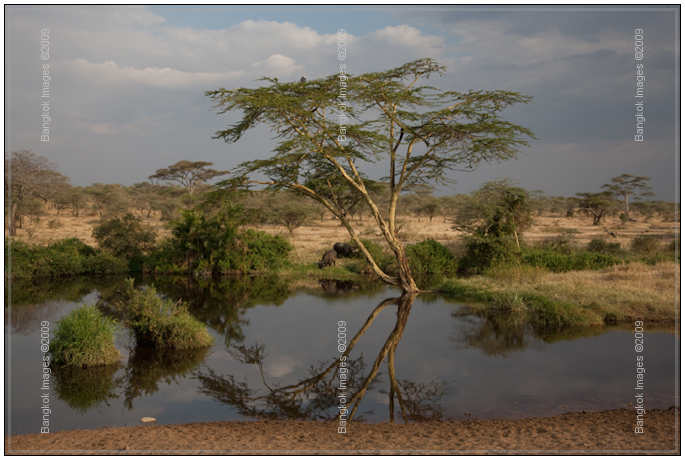
Two Cape Buffalo at a waterhole in the Serengeti
Canon 1 Ds Mark III, SS 1/640th, Av, f/8, ISO 400, Canon 24-105 mm IS lens @ 50 mm lens
I had a chance to use the 28-300 mm in Tanzania. It is heavy and expensive, and I liked it a lot. Maybe one time I will take it to replace my 24-105 mm. Don’t rely on the 28-300 mm as your only lens at the telephoto range. If you want to bring
home above average safari pictures you really need at least 400 mm on a safari.
My 500 mm f/4 IS is my workhorse, and if I were limited to only one lens on safari this would be it. I have thousands of safari photos taken with this lens in my Lightroom catalog. Many shots are taken at a significant distance and need this focal length.
When the 1.4X TC is added you get a nice 700 mm f/5.6 without significant image degradation. It is a little difficult to use in a bouncing vehicle due to its size. When you consider weight and cost, and difficulty of use (don’t forget you have to trudge it through airports),
for me its the lens of choice on a trip like this as compared to the larger and heavier 600 mm f/4 IS.

Striped Kingfisher
Canon 5D, SS 1/400th, Av, ISO 200, f/6.3, Canon 500 mm f/4 IS lens
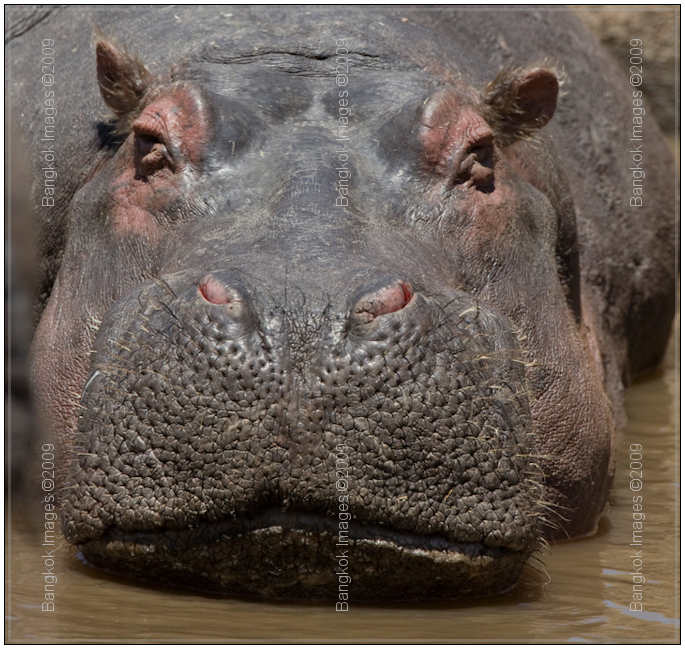
Even with a 1.4X TC the detail is retained
Canon 5D, SS 1/1000th, Av, ISO 400, f/8, Canon 500 mm f/4 IS lens with 1.4X TC
On my recent Tanzania trip I took the 400 mm f/5.6 as a backup because of my guests. It is easier to use than the 500 due to its weight and size. If you go on a walking safari I would highly recommend this lens over the 300 f/2.8 or 500 f/4.
It is an excellent lens for the price when you have adequate light and you have good technique. Using the 400 f/5.6 I had fast enough shutter speeds at f/5.6 and f/8 with an ISO of 400-800 to freeze the action and get the quality I wanted. My inexperienced
Tanzania guests used it most of the time and got some great photos. I might bring it again as backup for my next group, and if they don’t use it I will.
I used to bring the 300 mm f/4 IS and did like it, especially with the IS. I found the 300 mm was not long enough for safari pictures, and the quality of the picture not as good as the 400. So I sold it.
I own the 300 mm f/2.8 IS and love it in general. 300 mm is not enough focal length for an African safari so bring along a 1.4X TC to get it up to a proper 420 mm at f/4. Given that I bring the 500 mm f/4, and want to travel light, I do not bring my 300
mm.
Since I do not have any safari photos with this lens I will show you a shot from my Antarctica trip. I left my 500 mm home on this trip and brought along the 300 mm f/2.8 IS. It was the right decision because you get close to the animals and 300 mm focal
length is long enough. I will keep my 500 mm home and bring my 300 mm f/2.8 IS to Galapagos in March for this same reason.
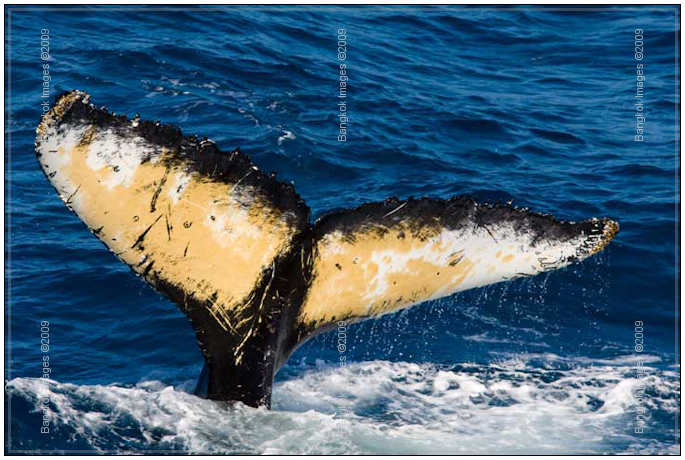
This humpback put on a show 75 yards in front of our expedition ship
Canon 1D Mark III, SS 1/2000th, Av, f/6.3, ISO 400, Canon 300 mm f/2.8 IS lens with 1.4X TC
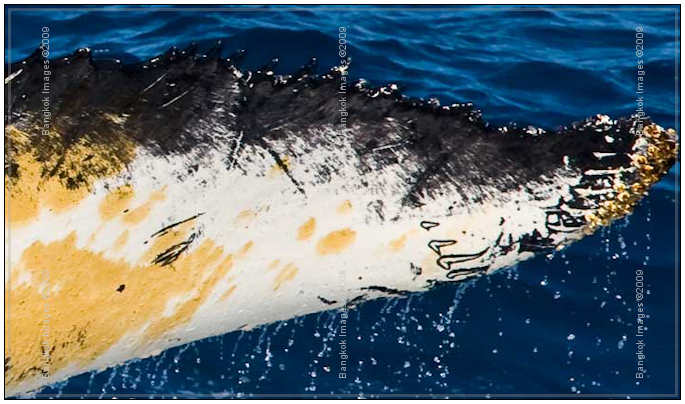
When you nail the focus with this lens it’s a thing of beauty
I used the 400 mm f/4 DO on my Kenya safari and did not think the quality was worth the price. For that much money get the 300 mm f/2.8 IS with a TC, or just get the 500 mm f/4 IS and get a superior, although heavier, lens for a little higher price. The
smaller size and weight of the DO lens is not that advantageous on a safari because you are shooting from a vehicle almost the whole time. If you have other uses for it when you return then spend time with it and the 300 f/2.8 and see what you
think.
The 70-200 mm IS Canon zooms, either the f/2.8 or f/4, used to accompany me on all my trips before I had my 500. They are great lenses if you can bring only one relatively economical lens on safari, and can be used in many situations when you return from
your trip. Frankly, for my style of photography and the time of day I am shooting, the extra weight and expense of the f/2.8 is not worth it.
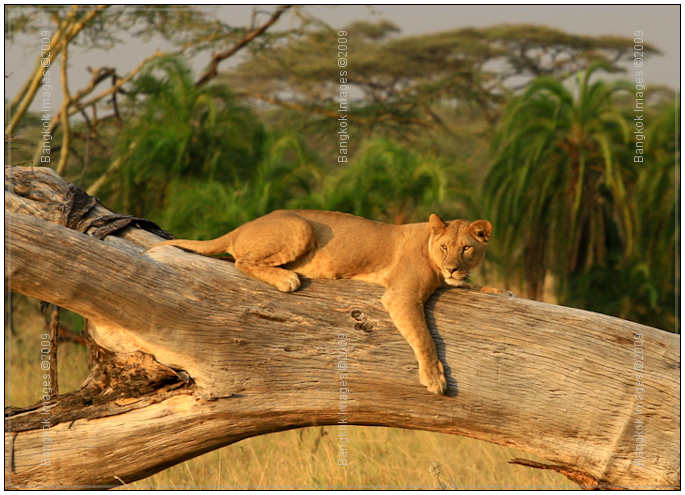
Lioness resting in the Serengeti
Canon Mark III, SS 1/750th, Av, f/5.6, ISO 500, Canon 70-200mm f/4 lens at 188 mm
I don’t bring my 70-200 any more because I want to travel light, and don’t find this intermediate focal length of advantage on a safari. Its not wide enough for those wide angle scenery shots, and not powerful enough for those distance shots
which make up the bulk of your safari photography. When I have my 24-105 on my Ds I get my wide angle at 24, and since the guide can get you close oftentimes, this lens becomes my intermediate lens at 105. If traveling light is not important to
you then bring the 70-200.
On the other hand, if you are a beginning photographer and do not own your equipment yet, this is a great lens when you want to travel light and can only bring one lens. When coupled with the Rebel series or the 20D, 30D, 40D, or 50D you have a winning
combination and will get lots of keepers. With their 1.6 FOVCP they help pull in those distant animals. Many beginning photographers used this combination on my Tanzania trip and were quite satisfied. After your safari this is a great camera and
lens combination for routine sports and people shots. The Rebels come with a wide angle zoom as part of the camera/kit combo.
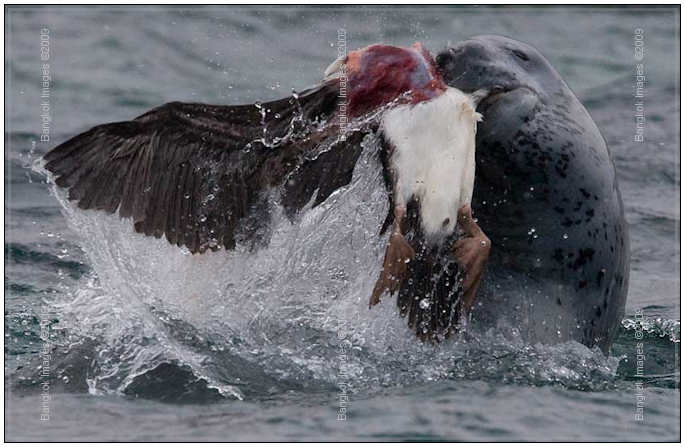
I still love the 70-200, and used it in Antarctica to capture this Leopard Seal as it demolished this Shag. This is an awesome predator to observe
Canon 1D Mark III, SS 1/2000th, Av, ISO 640, f/5.6, Canon 70-200 mm f/4 IS @ 200 mm
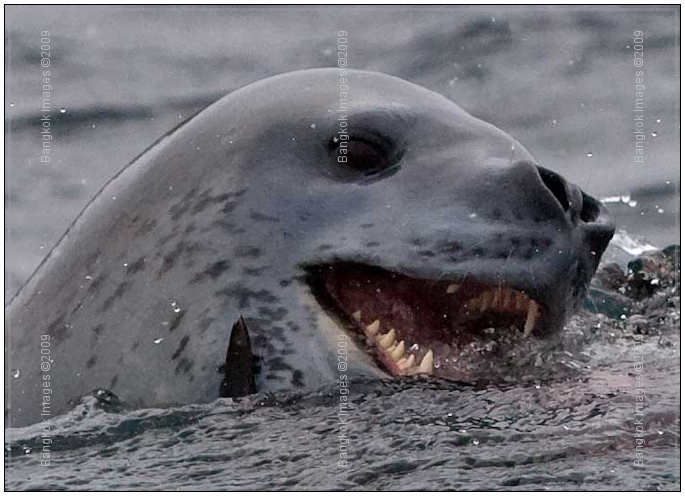
Watching him in action made the trip worthwhile
Canon 1D Mark III, SS 1/2500th, Av, ISO 640, f/5.6, Canon 70-200 mm f/4 IS @ 191 mm
I used a 200 mm f/2.8 on my Kenya trip in 2005 and loved it. It was small, light, and the photos were outstanding. I put my 1.4X TC on it, and with the 20D I was using at the time had an f/4 aperture with a focal length of almost 450 mm in 35 mm equivalent.
The quality of the lens was good enough that the TC did not degrade the photo. I think this is one of Canon’s sleeper lenses for the price, weight, and quality. I am tempted to bring this lens on a 3rd body for my next Africa trip if I
decide I am not going to travel as light as usual.
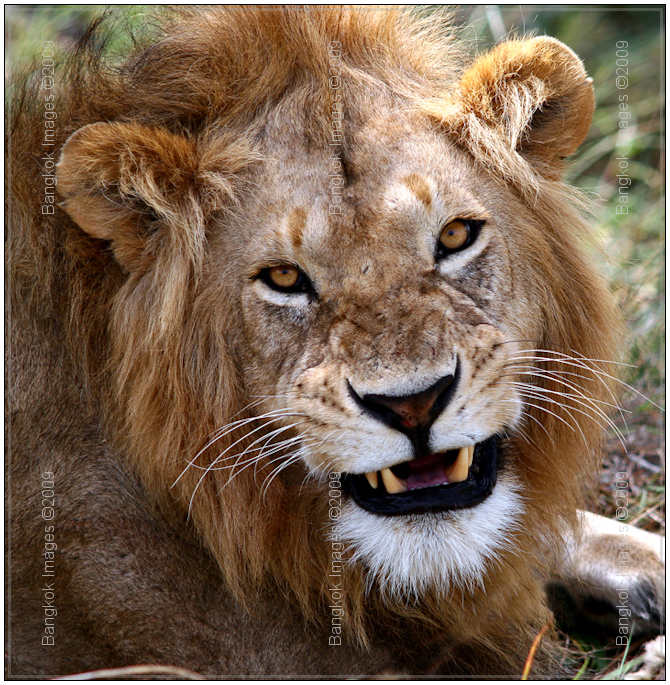
This male was a little perturbed when we got too close. It is rare for this to happen because the guides know how close they can get without crossing that invisible territory line
Canon 2OD, SS 1/800th, Av, f/4, ISO 200, Canon 200 mm F/2.8 lens with 1.4X TC
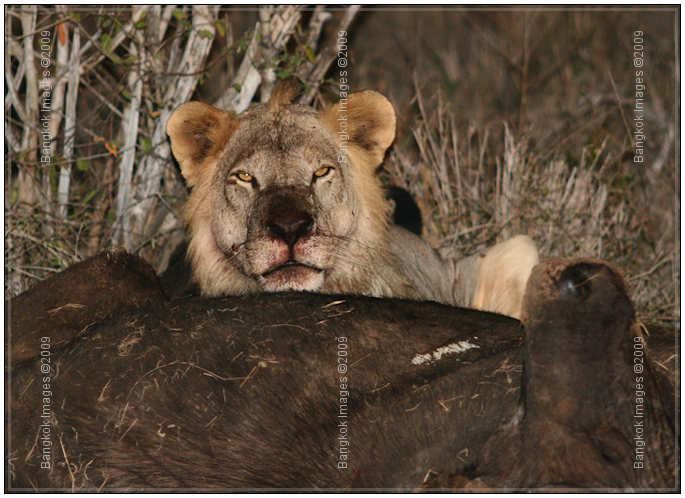
This is a maneless lion in Tsavo West National Park guarding a Cape Buffalo at night
Canon 2OD, SS 1/60th, Program, ISO 800, f/4, Canon 200 mm F/2.8 lens with 1.4X TC, flash
Do not underestimate how heavy some lenses can be after a few hours of shooting. This is not a problem in the vehicles, but might be a problem getting in and out of the vehicles, if you are hiking, trudging through airports, or back home for routine use.
The most important thing with all these combinations is to try them yourself and see what feels natural to you based on your budget and needs. Don’t make your decision just by reading about them. Whatever lens/camera combo you decide on
practice, practice, practice, shooting everything so your ability to use your camera and all its features becomes second nature.
For a little break from safari photography take a gander at these jungle pictures. They are scanned slides of a proboscis monkey, using a Minolta XG-M camera, and Minolta 500 mm mirror lens, taken by me in Borneo in 1991. If I remember correctly it was
fixed at f/8. I have no idea what my shutter speed was. I do know I was in Borneo, in a canoe with a Dayak (ancestors of the head hunters of Borneo), in a jungle surrounded by unusual wildlife, and
fulfilling a boyhood dream. Even though the photos are nothing to brag about they are mine, taken on my trip, and bring back a great memory of something I thoroughly enjoyed.
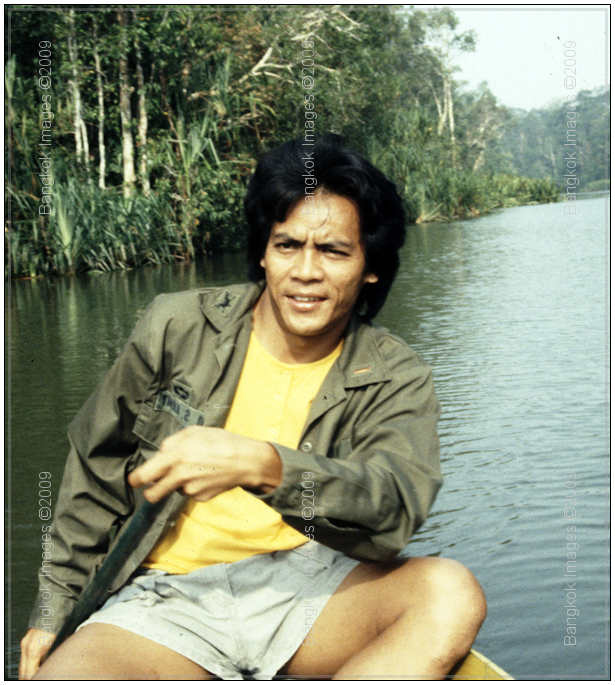
Uwil (they only go by first names) took me on a private canoe ride
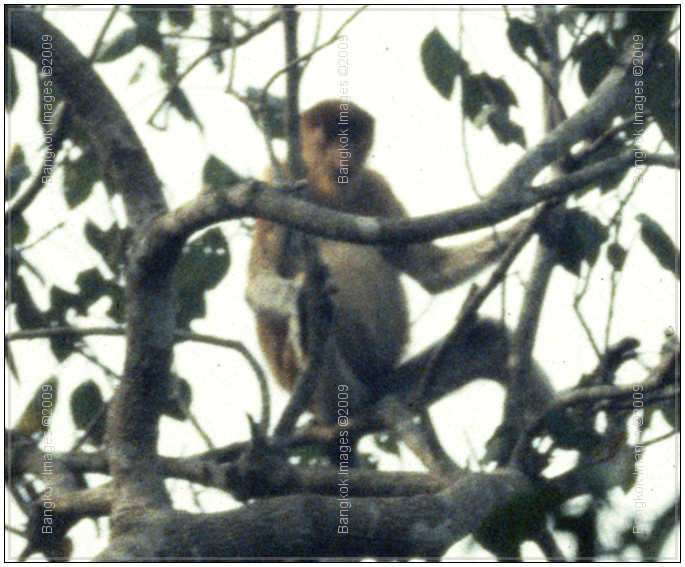
Proboscis monkeys have huge stomachs because they digest relatively indigestible plant material and they need a stomach full of bacteria to do this
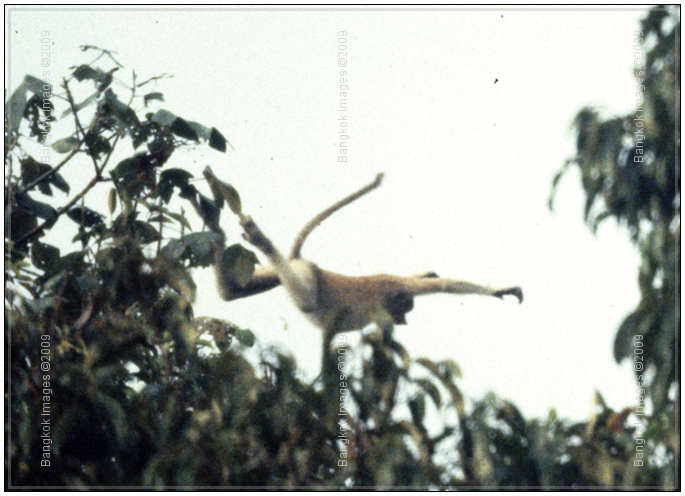
Its no small feat in a rocking canoe to catch one in mid leap. Every once in a while we would hear a thud. Mr. Uwil told me it was one of these monkeys missing a branch and crashing to the ground
Miscellaneous Equipment
Its easy to bring way too much equipment. I have even purchased photo gadgets I thought were great, and when I put them in my camera bag found out I already had purchased one years ago that I forgot about! Or, I go on the safari, and when I unpack upon
returning home realize I packed something I had no idea I brought along in the first place. Even though I am a believer of the better to have it and not need it, as opposed to need it and not have it philosophy of life, my advice is travel light
so there are less things you will forget at the hotels and camps as you move around.
I bring lightweight and very high quality binoculars. I find Leica and Swarovski the best. Some days I use them on safari, other days I do not. Most of the time they are not needed, especially since the guides have them and use them frequently for you.
The guides will get you close if it is not too dangerous, it does not bother the animal, and if the rules allow it. If you have great ones the guides might want to borrow them on occasion to check out a distant object. If you want to practice
your ability to find wildlife in the vast savannah then bring them. Another option is to have one person in your group bring a pair for all to share. You will only use them on occasion so this system works well.
I always bring a portable computer. I need it to teach on the trip and review photos for our photo contest. I also use it to back up my CF and SD cards and check focus and exposure and start my Lightroom editing during down time. I do not reuse cards,
so a full CF or SD card is my first copy of my photos. I back up to my portable computer’s hard drive and also to a portable external hard drive every night. I now have three copies of my photos. If I lose all these pictures I have another
excuse to go back and take them again!
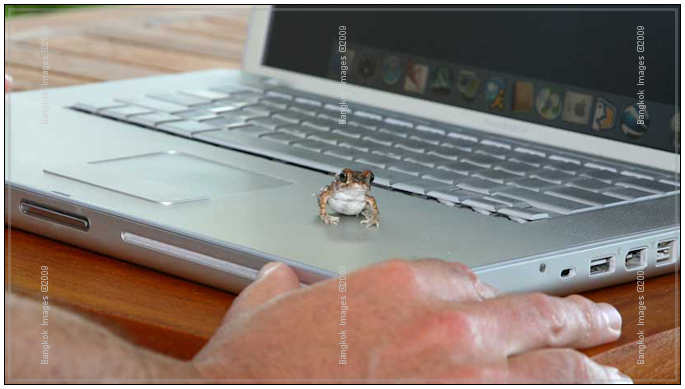
Another example of wildlife appearing when least expected
Some guests take up to 500 photos per day, although most people do not take quite this many. Since CF and SD cards are not expensive get more than you think you need. Base the number of cards you bring on 500 photos per day, then bring a few extra in
case you lose some or they malfunction. Buy the name brands and not some off brand because it is cheaper. I have made this mistake and had CF and SD cards that did not work well.
Most every place, including the mobile tented camps, has electricity to charge batteries. Make sure you have your European/African adapter kit for the different outlets. In the mobile camps the generator might only be on for a certain part of the day
so plan accordingly. If in doubt bring extra batteries. Even though I also bring a car charger for my batteries I have not needed it.
What do you do with all those photos?
I am going to give you tongue-in-cheek advice on what to do with all those photos you take on your safari. It might give you some perspective as you plan your trip and when you are actually on safari taking photos.
Now that you are back home from your safari and practicing on embellishing your travel stories, what the heck are you going to do with those 500 zebra photos? With the advent of digital photography it is not uncommon for a first time safari traveler to
take 5,000 photos. I even had one guest take over 8,000 on a ten day trip. By all means take as many as you want. You might not go back again, and it is fun to look at them years down the road to bring back fond memories and remind yourself that
you really do enjoy your life at times. Don’t forget to take photos of everyone on the trip interacting with you and each other, and not just animal photos. If you are going to shoot just animals then going to the zoo is cheaper.
I got stuck on an airplane once sitting next to a lady who was on a return flight from a safari. While her husband slept she just had to show me the photos on her Sony camera. Fifteen hundred (yes I said 1,500) pictures later we were done. It was a good way to pass the time on the flight, but I vowed never to put anyone through that torture again. I got tired of saying “hmm, nice photo”, and resorted to just nodding my head after a while.
The harsh reality is that few of your friends want to see as many photos of your trip as you want to show them. Even though you are such a good photographer that you will be showing them highly interesting, tack sharp, perfectly white balanced, beautifully
composed and properly exposed photos, not everyone feels as enthused about your photos as you do. They don’t have the time, money, and emotions invested in them as you do. Part of this is not your fault, its their insecurity and jealousy
that they did not take such a trip and cannot brag about it.
Use the KISS principle. In photography it does not stand for Keep It Simple Stupid. It stands for Keep It Short Stupid. You are probably not in Steven Spielberg’s league, so do yourself a favor and keep your friends as friends by not making them
sit down and look at photos ad nauseam.
Narrow your pictures down to around 20-30 of your best, and if your captives ask for more then you have carte blanche to pull out the remaining 5,000 that you think are great. In addition to animal photos they might also want to see where you stayed and
the people that went on the trip with you having fun, and not another sleeping lion.
Take your super duper pictures and print them out at the size you find appropriate to hang on your walls or put in your picture frames. If your friends ask about them you now have your opening to bring out all the other photos.
Of course I jest, just use common sense and realize that photography is very personal, and what might be interesting to you might bore someone else. Play it by ear with each group and get as much mileage as you can out of being cool enough to go on a
safari.
If you post pictures on one of the numerous public web sites upload only the best ones and give a little background information in addition to your EXIF data. As people scroll through your pictures you can make links to more photos. This is a good way
to let them decide how many they want to look at and not feel pressured to be polite to you in person while they roll their eyes at another photo they don’t relate to.
If you are doing a slide show to a live audience limit it to 30-60 minutes. Armchair travelers appreciate being invited and will feel a part of your trip if you take the time to prepare a good slide show. I have given around 100 of these to my clients,
family, and fellow veterinarians, and find them rewarding. It takes me up to 2 months working part time to prepare one.
People get bored rapidly looking at photos in a slide show, so unless you have a compelling story to tell about a particular picture, or are a particularly good speaker with a great sense of humor and a motivated audience, hit that “next” arrow quickly and keep it moving. Hopefully they will stay awake longer than 5 minutes.
I have a personal slide show/post trip party at my house for the people that went on the trip. I invite a few of them at a time, then their friends, then some of my friends and neighbors. This is their chance to show off their trip and the pictures they
took to their friends.
Making a professional style picture book with high quality photo paper to put on your coffee table is a great idea. Your pictures will come to life and will impress others for a reasonable cost. I have rarely seen one I did not like, and with the advent
of online templates it is easy to be creative. I am overdue on doing this because I spend so much time making slide shows and web pages for the people that go on my safari’s.
I put some of my best pictures on my iPhone and find it a great and informal way to share my trip anywhere. If people want to see more then I direct them to my web site.
For me, making a web page with lots of great photos and some good narrative that tells a story is one of the most powerful ways to share my trip with a vast audience. I love doing this, and it is my version of photojournalism. I include the pictures of
my guests having fun and the animal pictures they took on my web page so they can show off their safari to their friends.
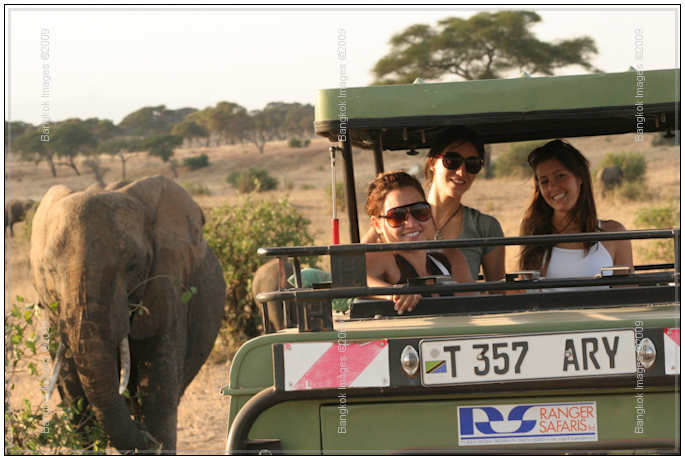
We got the animals and guests together on this shot
Canon 2OD, SS 1/500th, Av, f/10, ISO 1600, Canon 75-300 mm lens @ 95 mm
Further Reading
To see many more photos and narrative of some of my trips followthis link to my web site.
To learn about the complicated politics of wildlife in Africa the L. A. Times has a great article published November 7th, 2009.

National Geographic has a detailed description of modern Africa in the September 2005 edition. It is highly recommend reading
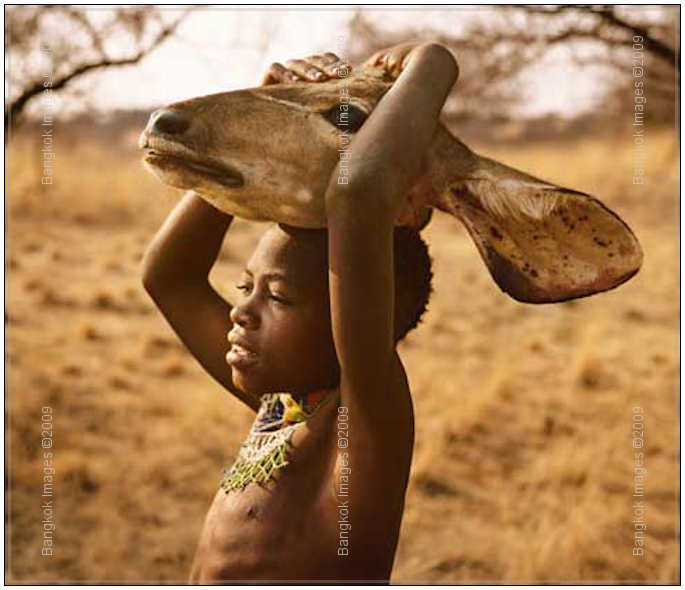
TheDecember 2009 (most current as of this writing) issue has a story on the Hadzabe in Tanzania, the location of my next trip in
February of 2009.
I mentioned earlier about Wilbur Smith and his Africa books. They are superb, entertaining, and educational.
To learn more from the experts and to psyche you up for your trip, check out these National Geographic documentary filmmakers I grew up with. If I had not been a veterinarian I would have followed in their footsteps
Derek and Beverly Joubert
Here is a link to their big cat initiative and how they are trying to save these cats from extinction.
And don’t forget to rent the movie “Out of Africa” to get jazzed about your trip. Most of the women that go on my trips love this movie. They ask me if they can fulfill their fantasy
by having me get Robert Redford to come to our camp and wash their hair like he did for Meryl Streep!
Conclusion
Save up for that future safari and go soon. Putting that hard earned money into a good safari company will increase your chances of getting those keepers more than buying the latest equipment. This also goes for learning wildlife behavior, practicing
with the equipment you already have, and that most important of qualities- patience.
Even though we take tons and tons of photos on a typical safari, I want to enjoy my guests, guides, local people, and scenery, and know when it is time to put the camera down or take my nose away from my computer screen. Keep it handy just in case because
I hope I have impressed upon you the fact that wildlife and good photographic opportunities can appear at any time. I have one final picture that might motivate some people to keep that camera ready.
I was walking around Heron Island at the southern end of the Barrier Reef taking photos of the idyllic beach. This black heron flew from the water to the beach when I did not expect it, but I practiced what I preach and got the shot. Notice the nice curves
of its feathers?
I will be back to Africa in February of 2011 because there is so much more I haven’t experienced and photography on a safari is a ball. I haven’t seen a mongoose and a cobra go at it, nor have I seen any wild dogs. Besides, I have missed
lots of photo ops due to mistakes galore and have another excuse to go back. Everyone is welcome to join me and my guests on future trips so you can make the same mistakes!
By the way, did I mention when wildlife usually appear?
